Atherton, one of the nation’s richest communities, has California’s highest concentration of electric cars.
Martin do nasciMento/ calMatters photo

Atherton, one of the nation’s richest communities, has California’s highest concentration of electric cars.
Martin do nasciMento/ calMatters photo
In Atherton, one of the nation’s richest towns, giant oaks and well-manicured hedges surround gated mansions owned by some of Silicon Valley’s most prominent billionaires, basketball stars, tech executives and venture capitalists.

Each set on an acre of land, six-bedroom estates, brickpaved pathways, neoclassical statues and cascading fountains are on full display. But increasingly, another status symbol has been parked in these driveways: a shiny electric car — sometimes two.
This tiny San Mateo County community — with an average home value of almost $7.5 million and average household income exceeding half a million
dollars — has California’s highest percentage of electric cars, according to a CalMatters analysis of data from the Energy Commission. About one out of every seven, or 14%, of Atherton’s 6,261 cars are electric.
CalMatters’ statewide analysis of ZIP codes reveals a strikingly homogenous portrait of who owns electric vehicles in California: Communities with mostly white and Asian, collegeeducated and high-income
A year after approving concepts for the redesign of Mace Boulevard (aimed at fixing what local residents dubbed the “Mace mess”), the Davis City Council on Tuesday approved design plans that will enable to the city to put the project out to bid.
residents have the state’s highest concentrations of zero-emission cars. And most are concentrated in Silicon Valley cities and affluent coastal areas of Los Angeles and Orange counties.
This racial and economic divide may be unsurprising — but it illustrates the mammoth task that California faces as it tries to electrify its 25 million cars to battle climate change,
See ELECTRIC, Page A4
 By Monica Stark Enterprise staff writer
By Monica Stark Enterprise staff writer

As we move our clocks twice a year, nurses working the night shift have to alter their internal clocks every day on the job.
“When night shift nurses drive home at 7:30 a.m., the daylight resets their circadian pacemakers in the retina. This daylight exposure amplifies desynchronization of the circadian rhythm,” according to a 1995 Journal of Holistic Nursing article by Joan Efinger, Lucille C. Nelson, and Julia M. Walsh Starr, titled, “Understanding circadian rhythms: a holistic approach to nurses and shift work.” The nearly 30-year-old article says that research found
increased awareness of circadian rhythms may help to reduce the multiple risks to nurses’ health and enhance quality of life and that there is a significant decrease in job performance and in satisfaction and quality of patient care.
In the hospital setting, researchers at the UC Davis California Lighting Technology Center are working to minimize these circadian rhythm disruptions with amber-orange colors and automatic lighting.

As CLTC director Michael Siminovitch, Ph.D. said, “We’re powering the human connection with lighting that makes sense.”
See LIGHTING, Page A5
But the council also voiced support for adding into the designs a two-way cycle track on the west side of Mace that will enable residents living to the west to bicycle more easily to destinations to the north such as Nugget Markets without having to cross Mace twice. Adding that to the project designs will likely delay putting the project out to bid by four to six weeks, according to city staff.
The changes approved by the council back in March 2022, and included in the designs approved Tuesday, include restoration of a second traffic lane in each direction as many residents of South Davis and El Macero had sought.
Those lanes were removed as part of a traffic calming and bicycle safety project that was completed in 2018 thanks to a $3 million grant from the See MACE, Page A5

 By Anne Ternus-Bellamy Enterprise staff writer
By Anne Ternus-Bellamy Enterprise staff writer

Eight months after filing a wrongful termination lawsuit against the Yolo Food Bank, former executive director Michael Bisch has filed a separate lawsuit in federal court alleging city and county officials violated his free speech and due process rights and defamed him, leading to that termination.
Named in the federal lawsuit are the city managers of Davis, Woodland and West Sacramento;


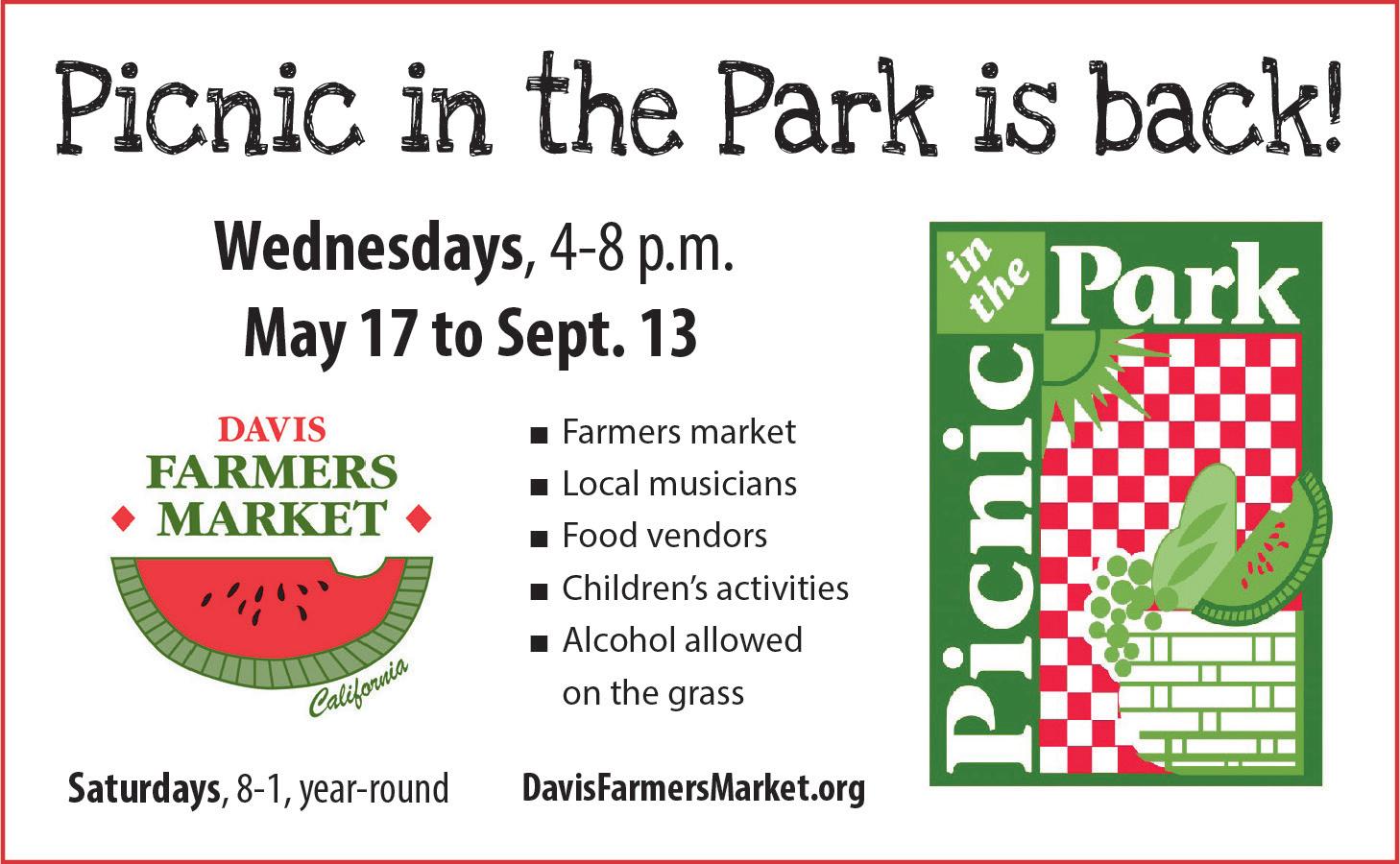
former Yolo County Supervisor Don Saylor of Davis and current
Supervisors Oscar Villegas of West Sacramento and Angel Barajas of the rural 5th District. Yolo County and the cities of Davis, West Sacramento and Woodland are also named, as is former interim County Administrator Chad Rinde (now the county’s chief financial officer).
Bisch is seeking damages for violations of his First and Fourth Amendment rights as well as for tortious interference with contractual relations and defamation.
“This case concerns
See LAWSUIT, Page A5

The Yolo County Elections Office will host a workshop for candidates and election observers in preparation for the May 2 special election.
The election is for Davis City Council District 3, where two candidates — Donna Neville and Francesca Wright — are vying to fill the seat vacated by former mayor Lucas Frerichs when he moved on to the Yolo County Board of Supervisors in January.
Candidates, campaigns, and those interested in observing the election process are invited to the elections office in Woodland at 10:30 a.m. on Monday, April 3.
The workshop, to be held in Room 106 of the County Administration Building, 625 Court St., will include information on ballots, ballot counting, results reporting and observing.
Later, at 1 p.m. that day, the elections office will publicly test the voting system to be used in the May election.
To attend, RSVP at https://www.surveymonkey.com/r/ FSDRR3M
There will be a postmeeting feedback survey sent to all attendees.
For more information, call 530-666-8127.

After more than a few decades of covering a variety of sports, I have some suggestions to make the games we play — and watch — even better.
Let's start with football, and if there's any time left we'll move on to completely hopeless sports like golf, bowling, cornhole and snowmobile racing. We'll open with the so-called "under further review" situation. Supposedly, the call on the field stands unless there is indisputable, provable-in-court evidence that contradicts the call on the field. Which is flat out stupid.
If it takes you five minutes of review, the evidence is clearly not indisputable, but usually, the fiveminute reviews end up with a reversal anyway.
I say it's time to review the review. The original call on the field has been made by one individual who had just one look at the play in question, from one angle only, and had to make the decision in the blink of an eye.
The review, on the other hand, has several sets of eyeballs, multiple camera angles, slow motion, stop action and can be decided in a room in New York even if the game is in Los Angeles. And they can take as long as they wish to come up with a decision, even
stopping for lunch if they so desire.
The better plan is that the several folks in the review booth should have no idea what the call on the field actually was. Just look at all the angles and make a decision. That decision is final, no matter what the call on the field might have been.
What, are they afraid of hurting the referee's feelings by overturning the call?
Even more frustrating is that some calls can be reviewed and others can't. What sense does it make to review whether a team had 11 men or 12 men on the field, but you can't review a holding call that eliminated a touchdown run?
Why can you review if a receiver's foot was inbounds or out of bounds, but you can't review pass interference or a face mask call?
Either review all the plays or none.
Sticking with college football, the intentional grounding rule makes no sense. For those who are unfamiliar with this rule, intentional grounding is called when the quarterback gets rid of the ball to avoid a sack.
So, the quarterback is 10 yards behind the line of scrimmage, faces a fierce pass rush and tosses the ball into the cheap seats to avoid a sack.
That's intentional grounding, and the penalty is that the ball is down at the spot where the pass was thrown, along with the loss of down.
Which is exactly what would have happened if the quarterback had been sacked. So there is no deterrent whatsoever to intentional grounding. Why wouldn't the quarterback throw the ball away?
To give the rule some teeth, a 10-yard penalty should be tacked on from where the pass was thrown.
If a team is ahead and trying to run out the clock in the final minutes, they can burn 40 seconds before snapping the ball. But, if they line up and jump offside, they're penalized five yards, but the play clock is reset and they can burn even more time off the game
Enterprise staff
The Davis Police Department announced the appointment of Todd Henry as the new deputy police chief on Wednesday. Henry comes to the the Davis PD with more than 26 years of public safety experience. He was with the Sacramento Sheriff’s Office for more than 25 years, where he held a wide variety of assignments before leaving as a captain in 2022. Most recently, Henry was the chief of field investigations for the Security and Law Enforcement Division of the California Lottery.
"I am humbled and excited to be joining this amazing department," Henry said, "and to play a role in the continuing development of a public safety model that reflects the values and expectations of the Davis community. I will work continuously to strengthen relationships with the community, accountability groups, and
McNaughton
Publisher Sebastian Oñate

Editor Shawn Collins Production Manager Louis Codone Advertising Director Bob Franks
regional stakeholders. Police-community engagement, transparency, inclusiveness, and being an approachable member of the city’s management team are some of my top priorities. It is an absolute honor to be part of such an engaged, thoughtful, and forward-thinking community."
While with the Sacramento Sheriff, Henry was a Sacramento Regional Incident Management Team member for five years and is credentialed with the California Office of Emergency Services as an incident commander. As part of this team, he responded to several large natural disasters throughout the state and has extensive experience in emergency management.
Henry has been a board member of the Sacramento Continuum of Care Board and is a board member of the Placer County Mental Health, Alcohol & Drug Advisory Board. While with the Sacramento
Sheriff's Office, he was responsible for developing a Homeless Outreach Team that worked collaboratively with various organizations to help navigate community members experiencing homelessness to services.
Henry also represented the Sheriff's Office in implementing one of the first Mental Health Mobile Crisis Response Teams in Sacramento County, pairing a mental health clinician with an officer. He has a strong background in community policing strategies and intelligence-led policing.
Henry has a master’s degree in criminal justice, with a concentration in administrative leadership, a bachelor’s degree in Criminal Justice Management, and is a graduate of the FBI National Academy and Sherman Block Supervisory Leadership Institute. He has been married for over 20 years to his wife, Lindsay, and has two children.
Special to The Enterprise
On Feb. 24, 2019 — 2/24
— the Davis Odd Fellows hosted the first Music for Natalie, a free community event, in memory of Natalie Corona.
It was an afternoon for people to share some time together and listen to music together. Officer Corona’s badge number was 224. The show started at 2:24pm with music provided by three area bands.
At the gathering, the Odd Fellows introduced their new Officer Natalie Corona Odd Fellows Memorial Scholarship program. Since 2019, the Davis Odd Fellows have made Music for Natalie! an annual event. The 2023 Music for Natalie! will be on Saturday, April 1, from noon to 5
p.m. in the parking area behind the Davis Odd Fellows Lodge and Lyon Real Estate at 415 and 401 Second St. It will be a free community event.
Once again, there will be live music on an outdoor stage with three bands led by Misner and Smith, 5 Star Alcatraz, and the Natalie Cortez Band. There will be pizza by the slice from Woodstocks, Handheld Sweet & Savory Pies, Nik Nek Lemonade, and a beer garden.
Want to be a Community Sponsor for Music for Natalie! 2023? Donations will be accepted and sponsors will be recognized at the event and on the website. Donations will help continue to fund the Officer Natalie Corona Odd Fellows Memorial Scholarship program.
Sponsor levels are Super Platinum Badge ($2,000 or more), Double Platinum Badge ($1,000-$1,999), Platinum Badge ($500$999), Gold Badge ($250$499), and Silver Badge ($100-$249).
For information, go to davislodge.org/officernatalie-corona-odd-fellows -memorial-scholarship, or contact Jim Bledsoe at jim@sunpoint.us.
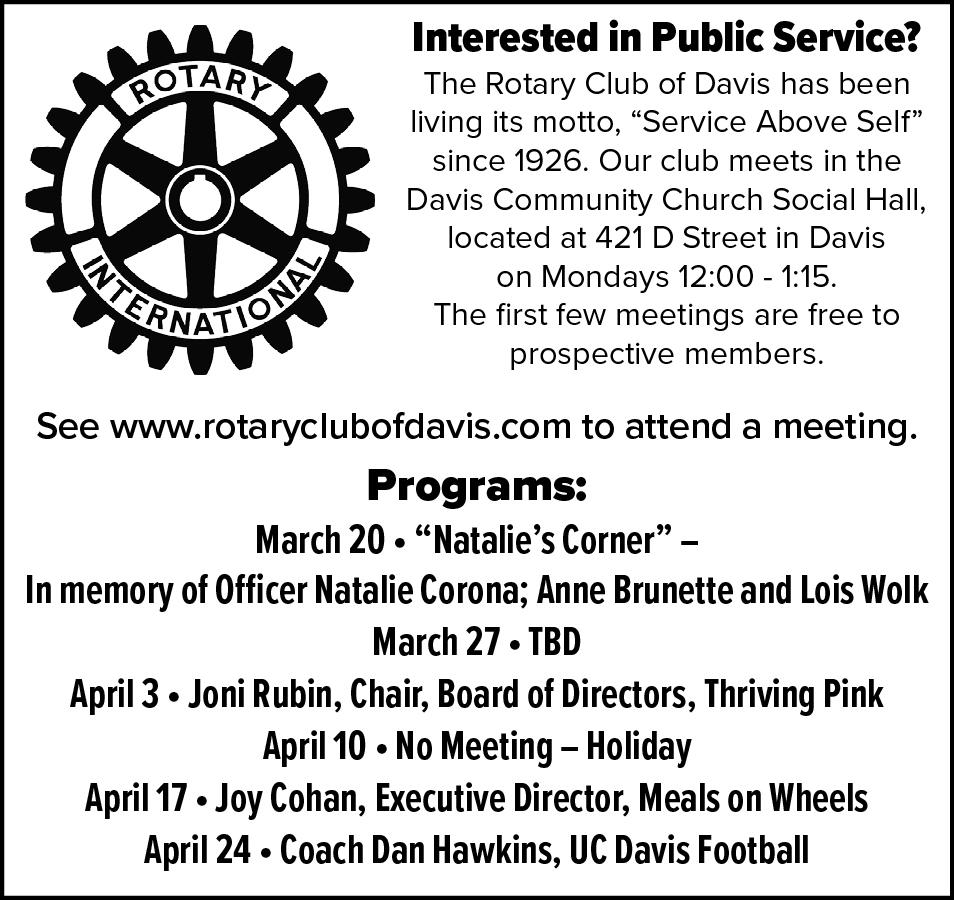
clock. Sac State did this effectively against the Aggies last November to preserve a 27-21 win.
The game clock should stop with the initial foul and not restart until the ball is snapped.
On the flip side of that, let's consider when the team that's trailing has the ball near the end of the game.
Let's say you're seven points behind and have the ball at the 50-yard line with 15 seconds to play. Time for two long passes. Maybe three.
But the other team has 12 men on the field during the first play and as a result, the play fails to gain any yards as the clock ticks down to 0:07.
Sure, you'll get a five-yard penalty on the other team, but you just lost eight critical seconds because of the defense's malfeasance. The solution is simple.The five yards are irrelevant compared to the time lost.
In the case of a defensive penalty in the last two minutes, the team with the ball should get the penalty yards plus the time back. Unless, of course, they don't want the time back.
College football is a great game.
But it could be better.
— Reach Bob Dunning at bdunning@davisenterprise.net.



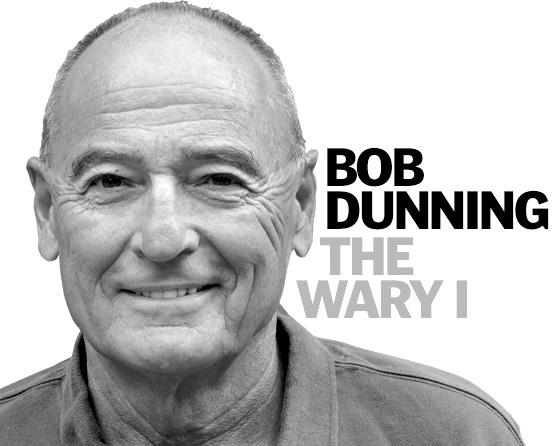
Special to The Enterprise WOODLAND — As part of National Music in our Schools month, members of the U.S. Air Force Band of the Golden West visited Woodland high schools on March 23 and held musical performances for students.
The six-member group, which includes an audio engineer, performed a mix of classic and modern songs from artists such as Shania Twain, Stevie Wonder, Bruno Mars and Dua Lipa, at Woodland and Pioneer high schools.
“A big part of our mission is sharing the Air Force story through music,” said Staff Sgt. Mike Roe, the band’s drummer. “Getting out into local schools is a great way for us to connect with communities.”
The USAF Band of the Golden West plays throughout Washington, Oregon, California, Nevada and Arizona. Band members also deployed to the Middle East last summer and performed in five different countries.
“Our 2022 deployment tour was a career highlight for me, and I’m sure for the other members as well,” said Master Sgt. Sam Kennedy, bass player for the band. “It was challenging to tour throughout the Middle East. But
it was very rewarding to provide a crucial morale boost to 27,000 deployed U.S. personnel and to remind them of home and why they serve.”
During the high school performances, students had the opportunity to ask the band questions in between songs about their experiences serving in the Air Force.
“The concert was great,” said Jovani Luna, a senior at Woodland High School. “I’m thankful for them coming out to Woodland and performing. Overall it was a great concert.”
“This was a great opportunity for our students to hear professional musicians who are also service members,” said Christina Lambie, WJUSD executive director of teaching and learning. “We’re grateful that the Air Force Band of the Golden West was able to visit our Woodland schools and share their talents with us.”
The band members included: Master Sgt. Sam Kennedy (bass), Tech. Sgt. Ryan Manzi (guitar), Staff Sgt. Mike Roe (drums), Airman 1st Class Natalie Angst (vocals), Airman 1st Class Keegan Bushouer (vocals), and Airman 1st Class Colten Mortensen (audio engineer).
“Do relatives make good neighbors?” UC Davis Distinguished Professor Emerita Sharon Strauss will answer this question and provide additional thoughts on species diversity in natural communities at the spring Emeriti Lecture in person and online on Monday, April 17, at 3 p.m.
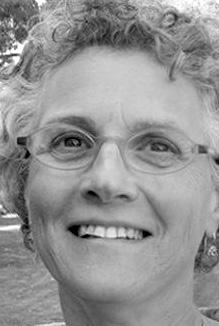
“Awed by biodiversity,” Strauss, a Distinguished Professor of Evolution and Ecology, presented this topic at a 2019 colloquium at the Institute for Advanced Study at Wissenschaftskolleg zu Berlin. In promotion of the event, Strauss wrote that the characteristics of species and how they interact with one another are shaped by both historical factors of past evolution as well as by contemporary interactions among species.
“There is a tension created by recent shared evolutionary history: shared ancestry should make species more similar and thus, these species should prefer the same habitats, food, etc. Yet, such shared preferences between species might also create conflict in the use of resources or habitat.”
In the write-up promoting the colloquium, Strauss stated that she’d
dissect “underlying mechanisms for a fundamental hypothesis that Darwin put forth on how the evolutionary relationship between species should affect the likelihood of their coexistence in local communities.” She wrote she uses “both experimental and observational approaches to explore this hypothesis. I then develop some novel mechanisms to explain the incidence of coexistence in closely related species.”
In 2020, UC Davis announced Strauss won the American Society of Naturalists’ Sewall Wright Award, which honors a senior and active investigator “promoting the conceptual unification of the biological sciences.”
According to the American Society of Naturalists, Strauss is “known for the breadth of her research and writings in ecology and evolutionary biology, with a focus on plants.” After she began this work on plant interactions with herbivores, she expanded to include interactions with mutualists (pollinators, microbes) and
antagonists (herbivores, parasites).
She argued early on those multispecies interactions, and indirect interactions, in particular, are important in shaping the dynamics, distribution, and evolution of plant populations.
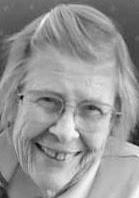
Distinguished Professor Walter Leal started the New Emeriti Distinguished Lectures to quarterly celebrate the accomplishments of the faculty who retired in 2021-22. The first in the series featured Professor Harris Lewin on Dec. 7, 2022. The winter quarter featured Emeritus Geerat Vermeij. Strauss will close out the year’s series.
After Vermeij’s talk, Dr. Estella Atekwana, the dean of the College of Letters and Science announced the formation of an Emeritus Club.
“Emeriti faculty really have a rich experience that should not be allowed to sunset just because they’re transitioning to what I call another phase of their lives.”
The video of the winter celebration with Vermeij, a poem by Dr. Andy Jones, and various short interviews appears here: https://youtu.be/ i7opv_2eIhM.
Organizers ask those interested in this event in person or virtually register at https://bit.ly/3JdFZBM.
Slide Hill Park in East Davis will be a “safety enhancement zone” during this year’s Picnic Day festivities.
The City Council on Tuesday evening voted to add the park to the list of areas in the city where penalties are increased for municipal code violations such as public urination and possession of open alcohol containers during a 36-hour period from 6 p.m. on Friday, April 14, to 6 a.m. on Sunday, April 16.
Since 2011, the city has authorized safety enhancement zones during the Picnic Day weekend in an effort to counter problems related to large parties and heavy drinking.
The safety zone was initially focused on downtown but was expanded to adjacent neighborhoods in subsequent years.
This year, following numerous complaints about hundreds of people gathering there, Slide Hill Park will be a safety enhancement zone.
“The parties occurring in
Slide Hill Park are large, involve consumption of large quantities of alcohol, and last year (2022) there was a large band that played music,” according to the staff report prepared for Tuesday’s meeting.
But staff recommended that rather than creating a safety enhancement zone for all neighborhoods surrounding Slide Hill Park, just the park itself should be one.
The park joins a large safety enhancement zone that covers much of central Davis, from Arlington Boulevard and Shasta Drive in the west to Pole Line Road in the east; Covell Boulevard on the north to Russell Boulevard and A Street south of downtown.
Signs will be posted at access points to each of the zones prior to Picnic Day warning of enhanced fines for specified offenses.
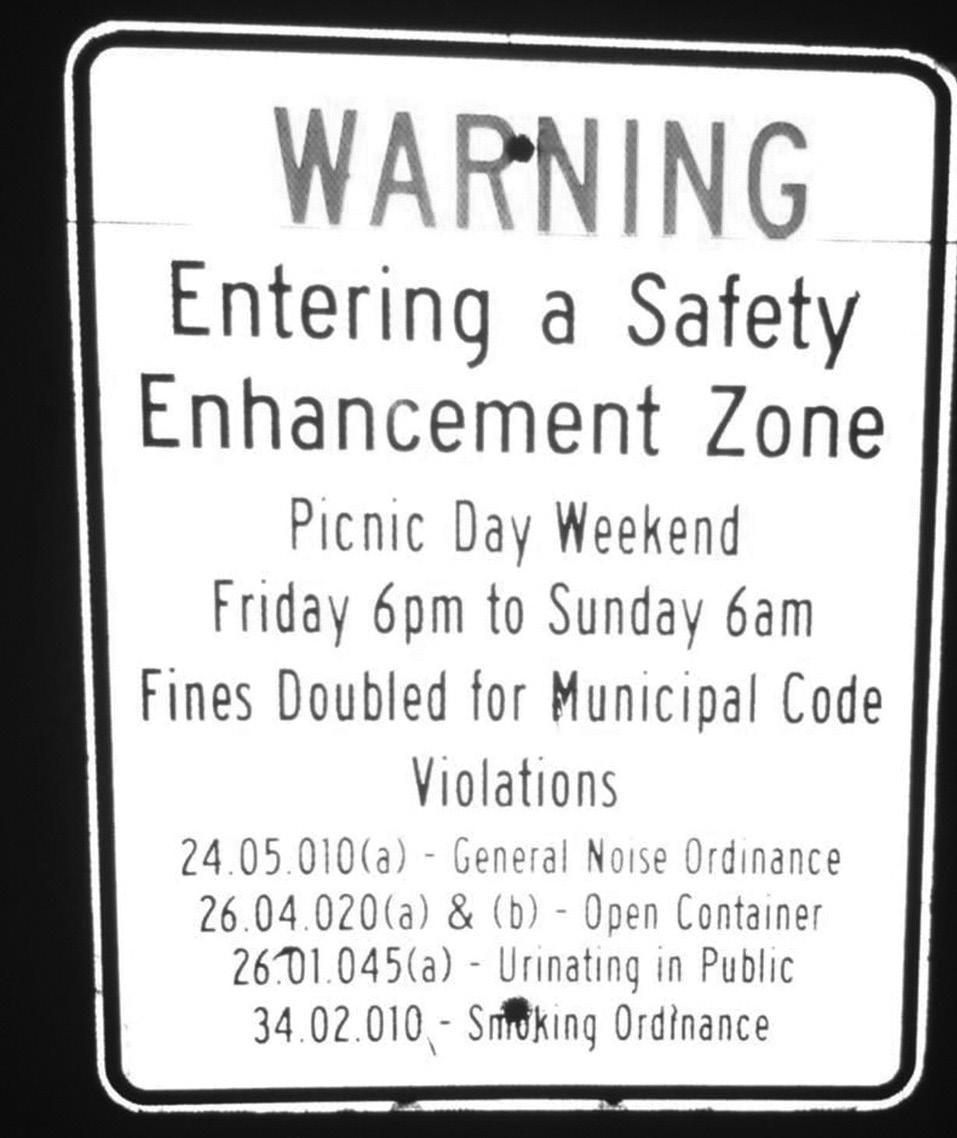
Violations of those offenses within safety zones come with a double-theusual fine up to a maximum of $1,000.
Specific offenses include prohibitions on loud noise; possession of an open container or consuming alco-
February 1928 — February 2023
Marilyn Trau died peacefully at home in Davis at the age of 95. She was born in Oakland to Marcella and William Wales. She grew up in Oakland and Niles during the depression years enduring many hardships, the most notable being when she and her brother had to live with relatives in what is now Fremont while her mother worked in another city to provide for them.
One of her greatest joys was when they could be reunited after a few years. She graduated from Holy Names High School in Oakland and began a long career of work in the service industry: first, at Hastings department store followed by many years with Pacific Bell then AT&T phone companies. After World War II, her
Areas of Davis will again become safety enhancement zones during Picnic Day weekend in April.
hol in public; urinating in public and smoking in public.
According to city staff, safety enhancement zones have seen significant calls for service during past Picnic Day weekends, “including several very large alcohol/drug-related
By Anne Ternus-Bellamy Enterprise staff writerThe county has issued a call for artists to paint a mural on a cargo container at the Yolo County Landfill.
A $5,000 stipend, sponsored by PaintCare Inc., will be awarded to the selected artist, who will paint the mural on two sides of the paint “Reuse Shed” at the landfill. The project encourages use of remanufactured paint, offered by Visions Quality Coatings, or free paint pulled directly from the landfill’s reuse program.
“Our vision is for this artwork to embody the Yolo County Central Landfill’s mission of promoting environmental protection while also integrating PaintCare’s mission of providing Yolo County residents and businesses free and convenient access to recycle and reuse paint,” said Interim Director of Community Services Leslie Lindbo. “We are looking
for high quality art proposals that will appeal to a broad constituency, as over 500 vehicles will pass by this artwork daily through the main landfill gates.”
PaintCare Inc. is a nonprofit organization that represents paint manufacturers in planning and operating paint stewardship programs in states and jurisdictions that pass paint stewardship laws. AB 1343 established the Paint Stewardship Program in California, requiring paint manufacturers to develop a take back system for leftover paint from household and commercial consumers. For application details, contact Waste Reduction & Recycling Supervisor Chelsea Callahan at ccallahan@yolocounty.org or 530-666-8812. The deadline for submittal is Saturday, April 15. Additional information can also be found at www. YoloArts.org by selecting “Call For Art” under the Artist Resources menu.
Special to The Enterprise
UC Davis will hosting internationally established writer and screenwriter Yan Geling to speak with the community on her works and experiences at from 4 to 6 p.m. Wednesday, April 12 in the International Center Multi-Purpose Room on campus.
Yan Geling is one of the most acclaimed novelists and screenwriters in the Chinese language and a well-established writer in English. Born in Shanghai, she served with the People's Liberation Army during the Cultural Revolution, starting at age 12 as a dancer in an entertainment troupe.
“White Snake and Other Stories.”
Many of Yan's works have been adapted for film and television, directed or produced by famous directors such as Zhang Yimou, Chen Kaige, Feng Xiaogang, Ang Lee, Li Shaohong and Joan Chen. She is a member of the Academy of Motion Picture Arts and Sciences.
Yan holds an MFA in Fiction Writing from Columbia College, Chicago. She has published more than 40 books and has won more than 30 literary and film awards. Her works have been translated into 21 languages.
younger brother introduced her to an employee at the gas station where he worked, and Marilyn and Frank Trau were soon married.
They welcomed their first daughter a few years later and moved from Oakland to the new suburb of Orinda, where their second daughter was born. They would continue to reside there for more than 50 years. Marilyn was active in social clubs, school activities and bridge clubs before returning to full time work in the ’70s. She had a lifelong love of baseball (her father played professionally in the minor leagues) and she enthusiastically followed the San Francisco Giants.
Marilyn was fiercely supportive of her children and a doting grandma to Liz,
Sara, Becky, Jenny and Kyle. Family was everything to her. She was a strong woman, exceptionally generous and passionately independent even in her final years when physical and visual limitations challenged her.
Nine years ago, Marilyn and Frank moved to Davis, living independently in their own home next-door to their daughter. While they were reluctant to leave their Orinda community, they found the neighborhood community in Davis to be a welcoming place. They adored having frequent visits from family and neighbors and especially their grand-dog Sammy. They truly valued their unique circumstances

parties with more than 1,000 young adults in attendance during the 36-hour operation period for Picnic Day.”
— Reach Anne TernusBellamy at aternus@ davisenterprise.net. Follow her on Twitter at @ATernusBellamy.
of being able to age-inplace near family.
After more than a decade with the PLA, she published her first novel in 1986 and has been writing constantly ever since. Her best-known novels in English are “The Secret Talker,” “Little Aunt Crane,” “The Flowers of War,” “The Banquet Bug and The Lost Daughter of Happiness,” and
Jonathan
d. Feb. 17, 2023
She has been subject to an unwritten ban in China since March 2020, when she wrote an essay criticizing the Chinese government’s handling of the COVID-19 crisis. She resides in Berlin, Germany, and has recently founded a company, New Song Media, to produce films and to publish her works outside China.
TRAU
Marilyn is preceded in death by her life partner Frank Trau, her beloved daughter Mary Ann, and many relatives and friends. She is survived by her brother Sam Wales, daughter Katie Horn (John) of Davis, five grandchildren and four great-grandchildren. Private services will be held in June.
Donations can be made to Juvenile Diabetes Research Foundation or the American Cancer Society.
Our beloved son, father, brother and friend Jonathan Earl Ekelund passed away on Feb. 17, 2023. Born in Sacramento to parents Darryl Ekelund and Barbara Sybert, he leaves behind daughter Trinity and many loving family members and loyal friends. Born on the first day of summer and Father's Day, Jon woke up every morning with a smile. We will miss his kind heart. May he rest in peace. Services will be at Parkville Cemetery in Anderson at a later date.
The Enterprise publishes brief death notices free of charge. These include name, age, city of residence, occupation, date of death and funeral/ memorial information. Paid-for obituaries allow for controlled content with the option for photos. Obituaries will be edited for style and grammar. Submissions may be made via www.davisenterprise.com/obit-form/. For further information about paid obituaries or free death notices, call 530-756-0800.


From Page A1
clean up its severe air pollution and reduce reliance on fossil fuels. Under a state mandate enacted last year, 35% of cars sold in California, beginning with 2026 models, must be zero-emissions, ramping up to 68% in 2030 and 100% in 2035.
But if people who buy electric cars are largely white or Asian, highly educated, wealthy, coastal suburbanites, will the state’s transformation succeed?
Will new electric cars be attainable for all Californians — no matter their race, income and location — in the coming decade?
High upfront vehicle costs, lack of chargers for renters and inadequate access to public charging stations in low-income and rural communities hamper California’s ability to expand EV ownership beyond affluent parts of the Bay Area and Los Angeles area. The cost of new electric cars is the most obvious factor driving the racial and income disparities in who buys them: The average as of February was $58,385 — about $9,600 more than the average car — although it dropped from about $65,000 last year. Lowerend fully electric cars start around $27,500.
Kevin Fingerman, an associate professor of energy and climate at California State Polytechnic University Humboldt, said the primary reason why more people in white, affluent, college-educated communities own electric cars is that they tend to be early adopters of new technology, with easier access.
“California is prioritizing the rapid electrification of the light-duty vehicle sector and it’s right in doing so. But it’s going to be important in the process to make sure that there is equitable access,” said Fingerman, who co-authored a study on racial and income disparities to electric vehicle charging.
To rapidly electrify the fleet, state officials must address the roadblocks causing the wide gaps in electric vehicle ownership: Expanding the state’s public and in-home charging networks, funding more rebates for low and middleincome residents and increasing the pool of used electric cars. The goal is to give consumers confidence in the reliability and affordability of the cars and reduce their anxiety about limited range and charging availability.
“As more electric vehicles are on the road, we’re going to need to be creative about policy solutions to address those issues to make sure that the benefits of owning an electric vehicle are shared across the demographics in the state of California and beyond,” Fingerman said.
About 838,000 electric cars were on California’s roads in 2021, and under the state mandate, it’s expected to surge to 12.5 million by 2035.
No statewide data exists to break down the race or other demographic characteristics of California’s car buyers. But CalMatters compared the ZIP codes of 2021 electric car registrations with Census information on the race, income and education of people in those ZIP codes. (Electric cars include battery-only models, plug-in hybrids and fuel-cell electric vehicles. ZIP codes with fewer than 1,000 residents were excluded from the analysis.)
California’s highest concentrations of electric cars — between 10.9% and 14.2% of all vehicles — are in ZIP codes where residents are at least 75% white and Asian. In addition to Atherton, that includes
neighborhoods in Los Altos, Palo Alto, Berkeley, Santa Monica and Newport Coast, among others.
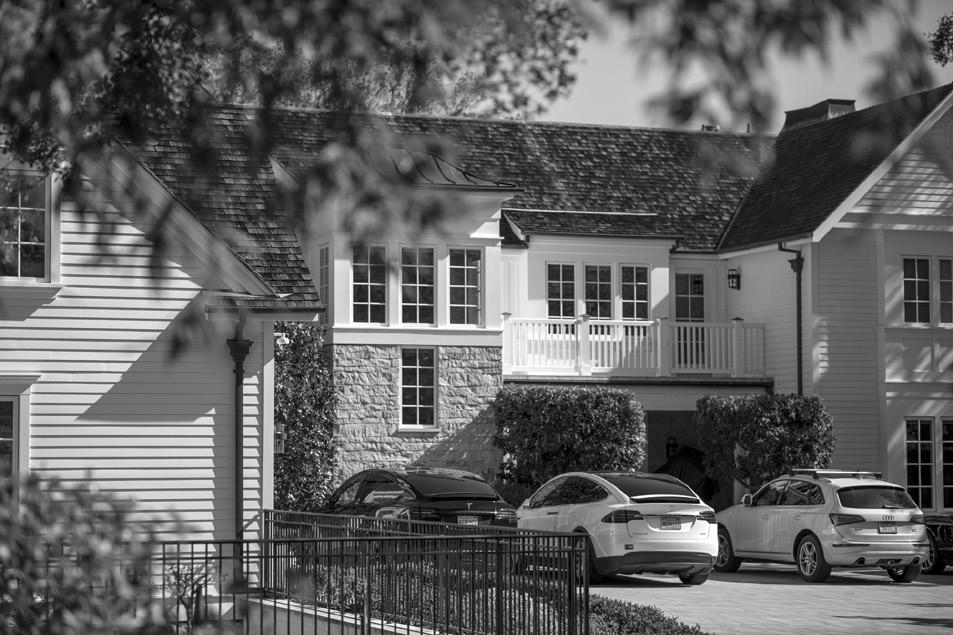
In stark contrast, California ZIP codes with the largest percentages of Latino and Black residents have extremely low proportions of electric cars.
In the 20 California ZIP codes where Latinos make up more than 95% of the population — including parts of Kings, Tulare, Fresno, Riverside and Imperial counties — between zero and 1% of cars are electric.
And 17 of the 20 communities with the highest percentage of Blacks have between zero and 2.6% electric cars. (Los Angeles’ relatively affluent Ladera Heights and two Oakland ZIPs have between 3.3% and 4.7%.)
Still, not all communities with a lot of electric car drivers are majority white. Four of the top 20 EV ZIP codes have more Asian residents than white. For instance, more than three-quarters of residents in Fremont’s 94539, which is ranked 14th with 11.4% of registered cars electric, are Asian.
Income seems to be a main driver of the disparities, according to CalMatters’ analysis. Most of the median household incomes in the top 10 exceed $200,000, much higher than the statewide $84,097. Typical home values in those communities exceed $3 million, according to Zillow estimates.
In contrast, electric cars are nearly non-existent in California’s lowest income communities: only 1.4% of
cars in Stockton’s 95202, where the median household income is $16,976, and 0.5% in Fresno’s 93701, where the median is $25,905. Most are plug-in hybrids, which are less expensive.
Also, at least three-quarters of residents in the top 10 communities for electric vehicle ownership have a bachelor’s degree or higher.
Rural and remote parts of the state — even the entire Central Valley — also are left out of the top ZIP codes with electric cars. With limited charging access, rural residents who drive long distances fear they’ll get stranded if their car runs out of juice.
“It makes sense why we would see way more concentrations of EVs in densely urban areas or populated areas,” Fingerman said. “The barriers to people owning electric vehicles across the demographics in the state are real. But they’re solvable.”
Black and Latino residents — who make up
almost half of California’s population — are less than half as likely as whites to have access to a public charger, according to the study Fingerman coauthored. Disparities in access are also higher in areas with more multi-unit housing, the study showed.
Yet interest in electric cars is high across all incomes and races, according to a 2019 survey conducted by Consumer Reports and the Union of Concerned Scientists.
About a third of survey respondents making $50,000 to $99,999 a year and under $50,000 a year expressed some interest in an electric car as their next
purchase. People of color also expressed interest, with 42% saying they would consider an electric vehicle as their next car.
Christopher Bowe, 48, of Hayward in Alameda County, considers himself an early adopter of new technology. He purchased his electric Ford F150 Lightning new for $70,000 late last year.
Bowe lives in a ZIP code where only 2% of cars are electric, but he lives next to Fremont’s 94539, where it’s 11.4%, so he regularly sees a lot of drivers with electric models.
Bowe, who makes a little more than $100,000 a year working for FedEx, said his income and living situation made it easy for him to opt for an electric vehicle: He lives in a single-family house with residential solar, which allows him to charge at home and keep his electric bill low.
Bowe had always been interested in buying an electric vehicle, but finding a pickup truck that suited his needs was a challenge for years. The 2022 F-150 Lightning was one of the first electric trucks to hit the market, and it
sold out quickly.
“I’ve always been a truck guy and everything previous was kind of small, underpowered,” he said.
“I’m a 300-pound guy. I like being up above the traffic and being able to see out in front of me. It fits my body size better.”
Bowe worries that the state’s 2035 timeline for 100% new electric models could be moving too fast because of the lack of affordable options. He said automakers should be given incentives to offer more affordable options.
The California Air Resources Board did build some incentives into its mandate: Automakers qualify for credits toward meeting their zero-emission sales target through 2031 if they sell cars at a 25% discount through community-based programs, or if they offer passenger cars for less than $20,000 and light trucks for under $27,000.
Automakers say they are working to speed up production and develop more affordable models. Tesla in January slashed prices for all models by 20%, which made the cars eligible for a $7,500 federal tax credit. Base prices are now $55,000 and $90,000.
Please look up my two books on Amazon
• Home Schooling: During COVID-19 and Beyond

• The Conscious Teacher
I taught in Davis for 27 years
These books will be helpful for teachers and parents I would appreciate if you would check in with me at dnpoulos@urcad org
City of Davis
Notice of Public Hearing
The City of Davis City Council will conduct a public hearing on the item, as described below, at a meeting beginning at 6:30 p.m. on Tuesday, April 4, 2023, in the Community Chambers, City Offices, 23 Russell Boulevard, Davis, California. Please contact the Department of Community Development and Sustainability for the approximate time this item will be heard.
Project Name: 3808 Faraday Avenue Right-Of-Way (ROW) Vacation
Project Location: 3808 Faraday Avenue
Project File No.: Planning Application #22-48 (VAC #01-22)
Property Owner/ Applicant: Buzz Oates Construction 555 Capitol Mall, Ste. 900 Sacramento, CA 95814


Project Description
The City Council is being asked to vacate approximately 0.52 acres of ROW located in front of 3808 Faraday Avenue. The existing street and parking configuration will be reduced as well as the length of Faraday Avenue, and creation of a cul-desac will be completed as part of
the 3808 Faraday Avenue project. The property owner will be responsible for maintenance of the vacated right of way area, and an easement over the area will be reserved for public utilities, and signage.
There is on file in the City of Davis Department of Community Development and Sustainability a map depicting the particulars as to the proposed vacation and retention of said easement of 3808 Faraday Avenue. The request for the vacation is being processed in accordance with the California Streets and Highway Code Section 8320 et seq.
Environmental Determination
The project is categorically exempt from further environmental review pursuant to Section 15301 which exempts existing facilities and 15305 which exempts minor alterations in land use limitations.
Availability of Documents
The project application file is available for review at the Department of Public Works, 23 Russell Boulevard, Davis, California, 95616. Staff reports for the public hearing are generally available five (5) days prior to the hearing date.
City Council reports are posted on the City’s website at: http:// cityofdavis.org/city-hall/citycouncil/city-council-meetings/ agendas
Public Comments All interested parties are invited to attend the meeting or send written comments to the project engineer at: City of Davis, Public Works Department, c/o Kevin Fong, Principal Civil Engineer, 23 Russell Boulevard, Davis, California, 95616; or via email at: kfong@cityofdavis.org
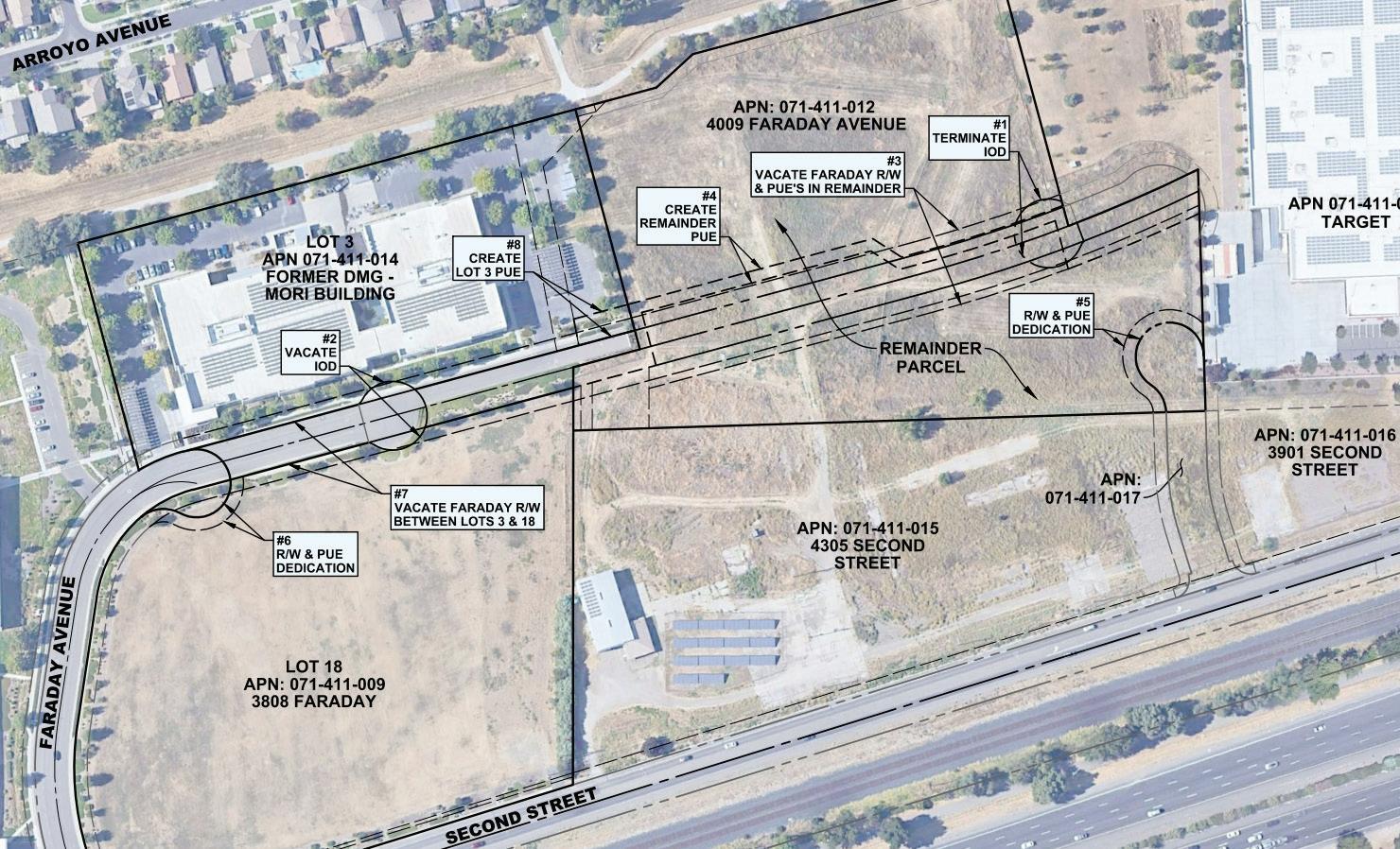
The City does not transcribe its proceedings. Persons who wish to obtain a verbatim record should arrange for attendance by a court reporter or for some other acceptable means of recordation. Such arrangements will be at the sole expense of the person requesting the recordation.
If you challenge the action taken on this matter in court, the challenge may be limited to raising only those issues raised at the public hearing described in this notice, or in written correspondence to the Director of Community Development and Sustainability or City Clerk at, or prior to, the public hearing. A figure of the right of way vacation is shown below.
In the research development phase, some deployments have been made in existing hospitals, where they put these nursing stations with circadian lighting. “We put test trials in there to see how the nurses and the patients like it. We’re getting sort of a thumbs up; this is great stuff.”
As the UC Medical Center’s California Tower opens to patients in 2030, it will be one of the first in the country to use a full portfolio of circadian lighting, which besides nurses will also benefit patients whose sleep gets impacted when nature calls in the middle of the night.
Inside the CLTC, sample patient rooms have orangish, amber-color light strips highlighting the baseboards circumventing the room; that way, when they get out of bed at night, they’re not stumbling, looking for a switch to turn on and not impacted by lighting that’s too bright or simply a color that can cause stress.
In July, the CLTC received a new grant to establish “The Color Lab” in collaboration with the
Center for Mind and Brain. The project’s goal is to explore the impact of discrete color spectra on stress, mind, and alertness, according to an announcement from the CLTC last year.
As you have it, “Orange light boosts brain power” was the headline of a March 19, 2014, article in Nature. The article discussed how the color of the light “could affect how well your brain functions…People exposed to orange light had more activity in the prefrontal cortex, which is involved in higher cognitive function, than those exposed to blue light,” according to the scientific article. “The findings suggest that a light-sensitive protein in the retina called melanopsin, which is primed by orange–red light and is not involved in vision, can influence cognition,” the article continues.
Many of CLTC’s recommendations become statebuilding standards, creating a ripple effect of energy savings.
Adaptive lighting for parking and exterior lighting has been applied widely throughout California, including the UC campuses. Such efforts support
UC’s Carbon Neutrality Initiative, which commits UC to emitting net zero greenhouse gasses from its buildings and vehicle fleet by 2025.
The CLTC turns 20 years old this year and “it feels like yesterday,” since it opened, Siminovitch said.
As a collegial agreement between the Department of Energy and Energy Commission and the Chancellor of UC Davis the innovation center began with the idea that it would help move

new ideas into the marketplace, improving efficiency of human factors and quality issues. Teaching classes was also part of it from the beginning.
That “human equation” of looking at the quality and color inside buildings has softened the approach of a very nuts and bolts electrical engineering kind of approach. Within the last two decades, the CLTC also has led the charge on an integrated approach to sustainability and deep
energy savings and can be credited with starting adaptive lighting or lighting that changes according to need. “The idea that you walk into a room and the lights get brighter, or when you leave it gets dimmer — exterior lighting, bathroom lighting, voltage, any hotel, bathroom, residential bathroom — all that lighting is because of us,” he said. “The idea here is very simple; these ideas can save a lot of energy and enhance safety and security.”
The center can be credited with helping the city of Davis lighting program, where for instance, on the bike path the lights come on as you travel along.
Private and public agencies help fund the center which includes research labs and product testing.
Per the CLTC’s website, the Institute works “in partnership with designers, manufacturers, end users, utilities, government agencies, and others, CLTC commercializes energy-efficient lighting and daylighting technologies, producing new technologies, inventions, patents, and license agreements. CLTC also provides engineering specifications, market research, resources, lighting guides, working papers, and white papers. The center conducts technology demonstrations, and publishes reports and case studies on these projects.
The center’s faculty and staff also provide curriculum and instruction for education and training courses, in addition to conducting workshops, seminars and outreach activities.”
— Contact Monica Stark at monica@ davisenterprise.net.

From Page A1
allegations of alarming constitutional violations, defamation, and tortious interference by a group of Northern California governmental entities,” the lawsuit states. “In brief, the governmental entities acted in concert to discredit, silence, and ultimately cause the termination of a talented and accomplished food bank executive director… whose work had benefited the community, shed light on important new food assistance legislation, and strengthened one of California’s leading food recovery and distribution nonprofits.”
Bisch was fired by the Yolo Food Bank in May 2022 and subsequently filed a lawsuit in Yolo Superior Court alleging wrongful termination, violation of whistleblower protection laws, breach of contract and defamation, among other complaints. He had served as the food bank’s executive director for four years.
In that lawsuit against the food
bank, Bisch alleged he was wrongfully terminated “after being subjected to harassment and retaliation for (his) goodfaith efforts to document and shed light on egregious noncompliance with SB 1383 by Yolo County and its cities…”
SB 1383 is a state law passed in 2016 that established methanereduction targets for California, including by reducing disposal of organic waste in landfills and recovering edible food for human consumption. For most residents, the key aspect of the law is the requirement to separate organic waste from trash, placing them in separate bins.
For the Yolo Food Bank, the key component relates to food recovery. The food bank procures food that would otherwise go to waste from sources like large food processors, wholesalers and grocery stores and is the primary edible food recovery service provider in the county, as well as its cities, including Davis, the lawsuit said.
SB 1383 also requires local governments to create local ordinances ensuring compliance, perform edible food recovery capacity assessments, develop additional capacity if needed, and, if expanded capacity is needed, to obtain funding for that infrastructure.
After joining the food bank in 2018, Bisch “pursued SB 1383 compliance nearly from the the outset,” the wrongful termination lawsuit contended.
However, he alleged, “representatives from the cities and Yolo County made it generally clear that they were resistant to complying with SB 1383 edible food recovery mandates and resistant to collaborating with YFB because they indicated that Yolo County and its cities were not willing to create a funding mechanism for the food recovery program mandated by SB 1383.”
From October 2021 to January 2022, the wrongful termination lawsuit alleges, Bisch was pressured by the food bank’s board of
directors “to stop speaking publicly to government agencies or third parties about the county’s and cities’ noncompliance.”
The suit also alleged unnamed local government officials were attempting to pressure the YFB board to “reign in and silence … Bisch.”
In response to that first lawsuit, the city of Davis issued a statement saying, “We have always appreciated the great work that Yolo Food Bank does for our communities to increase food and nutrition security.
“The city strenuously disputes the assertions made against the city in the complaint. Davis values its relationship with the Food Bank, and we look forward to working collaboratively to address the critical issue of food security.”
Now, in the federal lawsuit filed earlier this month, Bisch names the local government officials he alleges pressured the board to silence him. Those individuals, he alleges, “both individually and in
concert with one another, made and/or propagated defamatory statements about (Bisch) as part of Yolo County and the cities of West Sacramento, Davis, and Woodland’s effort to silence Bisch and to retaliate against (him) for his efforts in pursuit of food assistance mandates compliance, and/ or in furtherance of their own individual interests.
“Plaintiff Bisch has suffered loss of earnings and his employment, loss of reputation, and was wronged in the worst way possible — by county and city officials who were duty-bound to focus on the mission of serving the greater public good, but instead appear to have been motivated by retaliatory and other bad faith motives.”
Bisch is now seeking damages in his federal lawsuit.
Asked for comment on the lawsuit, the city of Davis responded with a statement that “as with any litigation, the facts of the complaint are under review by legal counsel.”
From Page A1
Sacramento Area Council of Governments to improve bicycle and pedestrian safety along Mace.
Removing a traffic lane in each direction made possible the addition of protective bike lanes.
But residents in the area immediately began expressing frustration about traffic congestion they believe was caused by the project.
Further compounding the problem has been the use of mobile apps like WAZE that divert drivers from I-80 onto Tremont Road then north on Mace where they get back on the freeway. Northbound traffic on Mace has been particularly heavy on Thursday and Friday evenings when many drivers are headed to Tahoe and other destinations to the east.
As part of the redesign approved by the council, there will be a pilot project conducted where a metering traffic light will be placed at the intersection of Tremont and Mace and, 30 days later, another at Montgomery Avenue and Mace to see if slowing traffic that way will reduce the number of drivers leaving I-80 in Dixon and using Mace to get back on the freeway before the causeway.
That pilot project will be key, according to Mayor Will Arnold, who said he
wanted to “temper expectations that adding an additional lane is going to relieve us of this Thursday night, Friday night, threeday weekend, traffic that we see.
“I’m concerned that the key here is not what’s in front of us today,” he said, “but that taking this aggressive action to meter the folks coming in to Davis is a critical piece of this when it comes to allowing the residents here to get where they need to go in a reasonable time frame.
“I think that is an absolutely critical path for us to protect this as a local thoroughfare and not as an extension of the interstate, which it becomes at times. So that work is … a critical next step.”
Vice Mayor Josh Chapman, who represents South Davis, agreed.
“We are not just increasing to two lanes to allow traffic just to fill up in those two lanes without doing metering lights and pilot programs,” he said.
“If we were going to open up capacity in this corridor, we do need to find ways to mitigate cars coming off the freeway and just filling up that corridor because there’s an extra lane.”
Metering lights, he said, could “literally throw off the calculation from WAZE, so that people realize that it may not be faster to get off the freeway. That is a big piece of what this
project puts forward.”
The whole Mace Boulevard redesign remains as controversial as ever, as evidenced by public comment during Tuesday’s council meeting.
While many residents urged the council to move forward with restoration of traffic lanes and some wanted Mace to be restored to the way it was originally, others opposed that move.
Jeffrey Bruchez, president of Bike Davis, said “it’s important to remember that this original project on Mace was a Safe Routes to School project. This was bid on in 2013 via a SACOG grant.”
That date matters, he said, “because it takes 10 years to make improvements like this. In those 10 years, we have improved the access for these children at Pioneer Elementary to get to school safely on their bikes, because this area is now safe and accessible for these vulnerable road users …
“Pioneer Elementary has recently been the highest mode-share of bicyclists,” he said, citing active4.me, which collects data on how many children are biking to school every day.
Back when the project was first approved, Pioneer had the fewest children biking to school.
“This project has been successful,” said Bruchez. “We have children riding to school. Is this an accident?
I don’t believe so. I believe it is an important measure of success for this project.”
He added that while he believes Mace needs improvements, “it’s really important to remember that a four-lane highway will only induce demand. We already know that some of this traffic in this area is bypassing I-80. If we increase the lanes, it will make this neighborhood congestion that everyone
here is complaining about only worse.”
But the council has long been in favor of restoring those traffic lanes and continued Tuesday to move forward in that direction.
Next steps include consultant Fehr & Peers completing a design for the two-way cycle track on the west side before putting the entire design out to bid. Construction will not begin
until the project returns to the council for approval of a contract award. Learn more about the Mace corridor project at https://www.cityofdavis. org/city-hall/improvement -projects/mace-blvdimprovements.
— Reach Anne TernusBellamy at aternus@ davisenterprise.net. Follow her on Twitter at @ATernusBellamy.
Special to The Enterprise
Lots of animals are waiting for “forever homes” at the Yolo County Animal Shelter, 2640 E. Gibson Road in Woodland.
Among them is Jessica (A201168), a 5-year-old tabby cat who is very social, friendly and affectionate. Jessica has a big personality and will make an entertaining companion. She is a fan of sitting on your lap at times and loves cuddles. Jessica is independent so fun is on her terms and will do best in a cat-savvy home with no small children.
Also hoping for a good home is Lucy (A200580), an energetic shepherdmix pup who's ready for lots of adventures. Lucy is a social butterfly and loves meeting new friends. She’s an expert walking partner and always has her nose to the ground discovering her surroundings. Lucy is a lovebug who needs exercise and lots of playtime.
For information on adopting, contact adoptycas@gmail.com. All shelter animals are up-to-date on vaccinations, microchipped, and spayed or neutered.
Staff is available to assist via phone during business hours at 530668-5287. Shelter hours are 10 a.m. to 5 p.m., Monday to Friday, and 10 a.m. to 4 p.m. on Saturdays. To meet any adoptable YCAS animals, visit friendsofycas.org. To volunteer, sign up at tinyurl. com/yolovolunteerapp. Follow on at @ycas.shelter and Instagram at @ yoloanimalshelter.

At Rotts of Friends
Animal Rescue, you’ll find Spike, an adorable neutered, male 1-year-old shepherd/Rott mix. Spike loves to play, especially with his ball. He’s medium-sized, gentle and very friendly. Spike walks calmly on leash, is not dog-reactive and loves being petted. He’s smart, funny and has a great tail


that never stops wagging.
Pickles is a 10-monthto 1-year-old spayed female Rottweiler. She is a very sweet, squishy, submissive happy girl who loves nothing better than a good old belly rub. Pickles is learning to walk on leash. She’s playful and loves people. Pickles will make a great family dog or a new best friend.

The next Rotts of Friends adoption event is from 8 to 11 a.m. Saturday, March 25, at 34505 County Road 29 in Woodland. Come by 10 a.m., as it takes at least an hour to meet and adopt a dog; everyone who will be
living with the dog should come out to meet it.
Bring proof of homeownership, such as a mortgage statement or property tax bill. If you rent, bring proof that you are allowed to have a dog in your home, such as a pet clause in your lease or a note from your landlord.
All dogs adopted from Rotts of Friends are healthy, microchipped, up-to-date on their vaccines and come with free lifetime obedience-training classes. For information, visit facebook.com/ rottsoffriends.
Thursdays in The Davisphere, the concert series launched in 2022 by Davis Downtown, will resume in August with new venues and activities, in five funfilled events.
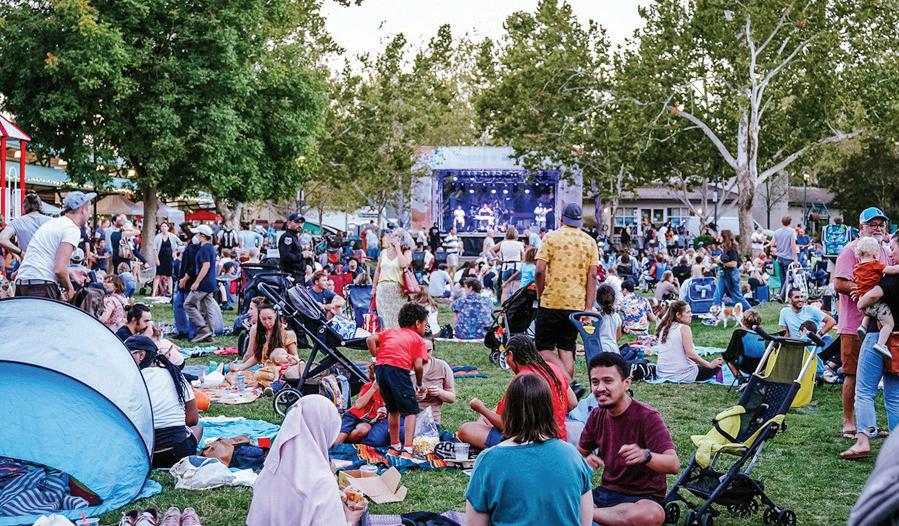
Thursdays in the Davisphere will appear in different areas of downtown, depending on the date. Brett Maresca, executive director of Davis Downtown, said the entertainment lineup and locations will be announced in the coming weeks. “We’re going to be testing a few different locations and a few different activities,” he said.

The 2023 dates are Aug. 31, Sept. 21, Sept. 28, Oct. 12 and Oct. 26. Hours are 5 to 9 p.m.
While significantly different events, the series complements the Davis Farmers Market’s Picnic in the Park, which will return on Wednesdays in May. Picnic in the Park will be from 4 to 8 p.m. May 17 through Sept. 13 in Central Park, Fourth and C streets. Along with the traditional
farmers market, it will have local bands, children’s activities and food vendors.
The remainder of the year, the market operates from 3 to 6 p.m. on Wednesdays, and year-round from 8 a.m. to 1 p.m. on Saturdays.
The inaugural season of Thursdays in The Davisphere was weekly in September and October 2022, thanks to funding from a city of Davis grant to revitalize local businesses emerging from the COVID19 pandemic. A follow- up survey showed a nearly 90% approval rating of the event, citing the energy and vibrancy it brought to the downtown. This year, Davis Downtown builds on this feedback, expanding it beyond Central Park. It will host five events between late August and late October.
The 2023 series “is designed to get people moving around downtown and involved with different businesses, not just in one area,” Maresca said.
The Davisphere event on Sept. 21 is timed to welcome returning UC Davis
students, and will include mobile food and beverage vendors as well as a beer and wine garden. Patrons are encouraged to purchase their food and drink from surrounding businesses as the event is hosted at additional locations downtown. Davis Downtown will continue to provide a designated nonprofit beneficiary to receive a portion of proceeds from participating bars and restaurants.
Davis Downtown is recruiting sponsors, vendors, bands and family entertainment acts. For details, email Autum Foss at autum@davisdowntown.com.
Davis Downtown leads and energizes the downtown as the primary business, entertainment and cultural center of Davis. Alive with activity seven days a week, downtown Davis draws locals and visitors alike to experience fine food and beverages, retail, professional services, arts and entertainment in an extraordinary and sustainable gathering place.

The Mondavi Center will be quiet over the weekend of March 24-26. But here’s a quick overview of three very different performances that will be featured as March fades into April on the following weekend.
■ Cabaret performer Meow Meow
— a stylish chanteuse with a piercing gaze, a billowing cloud of strikingly coiffed jet-black hair, and a penchant for creating arty shows with titles like “Beyond Glamour” and “Apocalypse Meow” (always performed with plenty of “attitude”) — will stride onto the Jackson Hall stage at the Mondavi Center on Friday, March 31, at 7:30 p.m., backed by a trio (drums, cello, piano).

Described by critics as a “crowdsurfing post-modern diva” (and described by herself as “a highly flammable woman”), Meow Meow has played grand venues (like the Sydney Opera House in her native Australia, and the Royal Albert Hall in London) as well as sophisticated little nightclubs. She sings in multiple languages and has organized a number of projects that involved members of Pink Martini, including the 2019 album “Hotel Amour.”
Tickets are $95-$35 general, available at MondaviArts.org and at the door.

■ Ranky Tanky with Dom Flemons is an ensemble of musicians who
hail from coastal lowlands of South Carolina. Their music draws on traditional Gullah music, which was created by descendents of enslaved Africans — you will likely hear African rhythms, a hint of jazz, Southern spirituals, plus some a capella singing and body percussion.

Ranky Tanky’s 2020 album
“Good Time” received a Grammy Award for Best Regional Roots Music album, and the group won a second Grammy this year for a live album recorded in New Orleanse. Ranky Tanky performs at the Mondavi Center on Saturday, April 1, 7:30 p.m. tickets are $65-$25 general, MondaviArts.org and at the door.
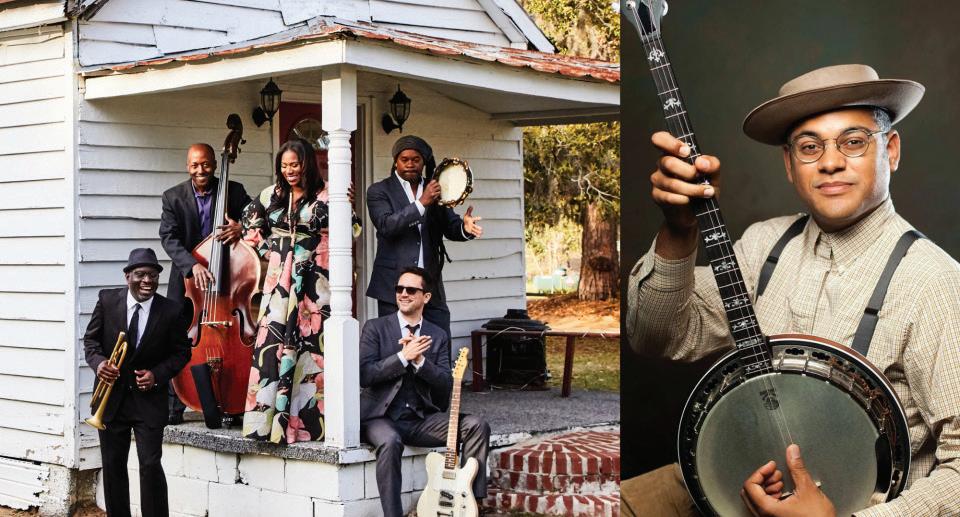
■ The Alexander String Quartet will return on Sunday, April 2, at 2 p.m. with the third installment of their series of concerts this season featuring the chamber music of Antonin Dvorák. The program will feature two substantial works: the String Quartet in A-flat Major, Op. 105, and the String Quartet in G Major, Op. 106, both dating from 1895, when Dvorák was a mature composer reaching the height of his powers. Music historian and composer Robert Greenberg will offer comments that will put this music in the context of the composer’s life and times. Tickets are $65-$35 general, MondaviArts.org and at the door.
I’ve always enjoyed my stuffed animals and usually add one to my collection every year or so. We tend to give them their own personalities and name them as well. They give us comfort and a sense of familiarity when we return home and children love to play with them and give them hugs. So who doesn’t love a story about a neglected little department store bear who is trying to find a friend to take him home?
Woodland Opera House has done just that with their Theater for Families show, “Corduroy,” based on the book By Don Freeman and adapted for stage by Barry Kornhauser.
Lisa (Zariah Williamson) sees the bear in the store and wants to take him home. But her mother (Deborah Douglas) points out that they don’t have extra money to spend on the bear and, besides, he looks very old and is missing a button on his overalls.
Lisa names him Corduroy (Eddie Voyce) after his green overalls and the bear comes to life. We assume the bear wants to look his best so he can go home with his new friend Lisa and the show follows Corduroy’s quest to find his lost button.

As Corduroy searches for the button he gets into many situations where he messes up different departments in the store. The night watchman (KG Rucker) is baffled and frustrated, and assumes there is an intruder to be found.
Rucker is a master at slapstick comedy throughout the performance and perfect for this show after her recent training in physical theatre at the Academia dell’Arte in Arezzo, Italy.
Voyce uses his physical being to express his determination and emotions to entertain the audience.
Whether it’s navigating an escalator, climbing a pyramid of laundry soap on display or diving headfirst into large boxes, veteran actor Voyce makes it look effortless.
There are three other actors who don’t say a word on stage but are constantly changing the sets, cleaning up the many messes and introducing the scenes. Lauren Battaglia and Arlo Wylene were totally in sync as they cartwheeled their way through the show as the mannequins and clowns with a ton of stamina and skill. It kind of reminded me of a boxing match the way they introduced each scene with a rectangular sign.
Because there is almost no talking by half the
actors, the music and sound-board operator had the difficult task of learning all the visual cues to make the myriad sound effects. Congratulations to Marcia Gollober for getting everything just right. Also, there is a comedic robotic vacuum cleaner played by Cameron Fuller who was a huge hit with the kids.
And speaking of kids, Williamson reminded us how difficult it can be to do
things properly when we are young and inexperienced. But Lisa never gives up. She is lonely and shy to make friends at her new school. Williamson slides right into her character as a young girl even though she is an adult. The mother starts to see the importance of having Corduroy in her daughter’s life and the need to care for something of her own.
Douglas balances her role as a single mom with
tight finances to both teach her daughter responsibility and compassion and the two share good chemistry between them. It was heartwarming to see the many children bring their own teddy bears to the show. During intermission and after the show, many of them ran up to collect confetti to bring home as souvenirs. If you have elementary-aged kids who like slapstick comedy and stuffed animals, they
Eddie Voyce is Corduroy in the Woodland Opera House production of “Corduroy.”
will love this show.
Kudos to Director Ania Mieszkowska and her production staff and crew for making this classic book come to life. Because every one needs a friend, even if it’s just your favorite stuffed animal.
Performances are Friday nights at 7:30 and Saturday and Sunday matinees at 2 p.m. through March 26. Tickets available @ WoodlandOperaHouse. Org.
Enterprise film critic

I cannot imagine the mental and emotional anguish of survivor’s guilt.
But Florence Pugh certainly conveys it persuasively, in this three-hanky melodrama.
Writer/director Zach Braff’s film runs a bit too long, and he arguably lards the third act with one reckless transgression too many. That said, viewers may be inclined to forgive that excess, given the strong performances which take us to that point.
The story opens on a cheerfully rowdy pre-wedding gathering. Everybody has had a bit too much to drink — or smoke — while singer/songwriter Allison (Pugh) gamely performs one of her tunes on piano. After the guests disperse, she and fiancé Nathan (Chinaza Uche) enjoy some quality quiet time, displaying the flirty, playfully sexy nature of their relationship.
The following morning, Allie — as she prefers to be called — Nathan’s sister Molly (Nichelle Hines) and her husband leave their New Jersey neighborhood, intending to spend the day in Manhattan: trying on dresses, then taking in a
play. As it’s a school day, their teenage daughter, Ryan (Celeste O’Connor), has been left behind with her grandfather, Daniel (Freeman).
The car chatter is lively; Allie’s eyes — she’s driving — keep straying from the freeway. She then worsens the situation by pulling out her phone, to check a map reference.
Braff, bless him, cuts to sharp black.
Our first glimpse of Braff’s delicate touch with deeply emotional scenes — and dialogue — comes next. Daniel, in the process of dropping Ryan off at school, gets The Phone Call. Freeman plays the scene wholly by the reaction in his gaze; we don’t hear the other end of the conversation. Then, the call concluded — sinking further into shock by the second — Daniel encourages Ryan to have a good day at school.
He gives the girl those precious few more hours of
“normal,” before her life is ripped apart.
Allie, badly injured, wakens in a hospital bed. Nathan and her mother, Diane (Molly Shannon), are present. A police officer enters the room; chaos ensues.
Molly and her husband died in the crash; Allie survived.

Flash-forward one year. Allie, back in her mother’s home, remains an emotional wreck. She’s also hooked on pain pills, and the saga resumes at the point where — her various doctors, fully aware of the situation, having cut her off — she desperately “needs” another OcyContin prescription.
Diane wants to help — recognizes the increasing severity of Allie’s out-ofcontrol frenzy — but is far from an ideal ally, given her
own red wine-and-pill dependence. Nathan, alas, is out of the picture; Allie abandoned him months back.
Elsewhere, Daniel has been doing his best to raise Ryan on his own … and making absolute hash of it. The girl is a star soccer player, formerly on track to gain a full-ride scholarship … but more recently has been mouthing off to her teachers, and getting into fights (for which she’s illequipped). Daniel hasn’t the faintest idea what to do.
When not arguing with Ryan, Daniel finds peace with his basement train set: an elaborate scale model of their New Jersey neighborhood, laden with hand-painted figures that represent the people whose paths have crossed his life: where he can imagine the roads that weren’t taken,
and a life that might have turned out differently.
Daniel, a former New Jersey police officer and recovering alcoholic — 10 years sober — has been long estranged from Nathan, who fled from his father the moment he could. Nathan may be the most grounded, but he’s also burdened by emotional baggage relating to that estrangement. Diane is pretty much useless; Ryan is on a fast track to ruining her life.
Then there’s Allie, whose increasingly irresponsible and reckless behavior sets our teeth on edge. Pugh plays her deterioration superbly, her clammy skin, predatory gaze and withdrawn, hunched posture amplified by pitiful pleading and angry outbursts.
The story’s slide into its second act is triggered by
Allie’s gutsy decision to attend an AA session … which happens to be Daniel’s weekly group. They lock eyes, likely “meeting” for the first time, despite both knowing full well who the other is.
It’s tempting to wonder if what follows ever would happen in real life. It seems unlikely, but some people do have an impressive capacity for forgiveness and redemption. Regardless, Freeman and Pugh make it work. Along the way, we learn more key details about things past; again, it feels organic and authentic.
But then we hit the third act, and Braff injects one irresponsibly rash scenario too many: something from which, in the real world, coming back would be impossible. And what follows does feel contrived, despite the game efforts of all the actors.
Except for Shannon, who is this film’s weak link. Never a strong performer, she’s quite distracting here: too shrill, given to wooden line readings, her “acting” all over the map. It’s impossible get a bead on Diane; she never becomes credible.
Braff’s film certainly hits far more than it misses; bathing in this soapy melodrama isn’t too difficult, given the intensity of Freeman and Pugh’s work.
But do bring along plenty of Kleenex. You’ll need ’em.
— Read more of Derrick Bang’s film criticism at http://derrickbang. blogspot.com. Comment on this review at www. davisenterprise.com.
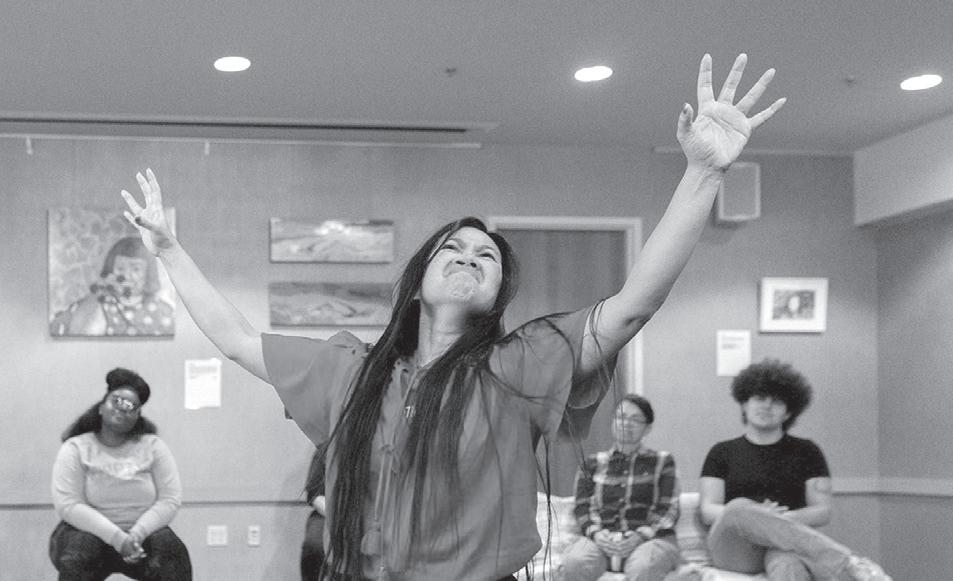 By Wendy Weitzel
By Wendy Weitzel
Special to The Enterprise Davis artists and nonprofit arts organizations benefited from more than half a million in American Rescue Plan funds distributed in recent months.
The largest amount –$500,000 – went to stabilize the city’s nonprofit arts and culture sector, which saw substantial economic impacts during the pandemic. The Yolo Community Foundation administered and selected those 20 winners, with organizations receiving between $5,000 and $45,000 each. In addition, the city chose 50 individual Davis-based arts and culture applicants to receive grants of $1,000 each.
Rachel Hartsough, the city’s Arts and Culture manager, said, “We can’t overstate how important this support is to the work of local artists. Their collective efforts improve our quality of life in so many ways. The arts and culture sector strengthens our local economy, provides an important tool for gathering in times of celebration and mourning, creates individual and civic pride, builds community within neighborhoods, attracts out-of-town visitors, amplifies the voices and faces of marginalized members of our community, and supports initiatives that promote health and wellness. And, of course, the arts bring joy and beauty into our lives.”
That echoes an October 2021 op-ed printed in The Davis Enterprise, written by Autumn LabbéRenault, then-Arts Alliance Davis chair, who is executive director of Davis Media Access. Signed by 22 members of the Alliance, it argued that arts and culture were essential to local economic vitality yet were often overlooked in pandemic relief funding. Besides providing jobs, local events boost the coffers of hotels, restaurants, bars, shops and cities, it said.
Shelly Gilbride, executive director of International House Davis and new chair of Arts Alliance Davis, was one of those who signed the op-ed, and asked the City Council in November 2021 for a share of its ARP funds. The Alliance received all $600,000 of its request, with $50,000 of it going to YCF for administration and support.
The grass-roots group argued in its proposal to City Council that arts “are fundamental to the health and vibrancy of our community. These organizations are responsible for keeping us informed, bringing color and beauty to our environment, providing a means of expression and, most importantly, bringing people together to combat isolation, move, find joy and participate in our shared experience as a community.”
The letter asked the community “to imagine what happens if the organizations you’ve come to rely on cease to exist. Where would you turn for after-school workshops, summer camps, intern opportunities? Who would bring live music, dance and theatrical productions to town?”
The grants to local nonprofits provided muchneeded general operating support to help them on the path back to financial sustainability. Many organizations still struggle from lingering effects of the pandemic on their operations, staffing and facilities. As part of this program, the YCF provides non-financial assistance like free training programs for the year.
Nonprofit organizations receiving $45,000 were Davis Arts Center, Davis Media Access, Davis Musical Theatre Company, International House Davis, and Pence Gallery Association. Those awarded $30,000 were Bike City Theatre Company, Davis Shakespeare Ensemble,
and Imagining America (UC Davis). Grants of $20,000 went to Acme Theatre Company, Applegate Dance Company, Davis Community Chorale, Music Only Makes Sense (also known as Davis Music Fest and Davis Live Music Collective), and Pamela Trokanski Dance Theatre. Awards of $15,000 were presented to Chamber Players in Davis, Davis Independent Music Initiative, Davis Repertory Theatre, Mariachi Puente, and Stories on Stage Davis. Davis Korean School and YoloSol Collective rounded out the list with $5,000 each.
Recipients not only appreciated the grants, many said they couldn’t have survived without them. Oona Hatton, coartistic director for Davis Repertory Theatre, said the $15,000 it received went a long way. “Thank you so much,” she told those at the Feb. 16 Arts Alliance Davis meeting, in appreciation of their advocacy. “Our whole season is funded by that grant.” Davis Repertory Theatre is partnering with the Stephens Branch Library, 315 E. 14th St. in Davis, to host a series of Saturday performances in March, April and May. “Gynecologos” was a March 18 performance about gender, sexuality and reproductive health. “En Las Sombras,” at 1 p.m. on April 15, is a
parable where siblings battle gods to rescue their mother. And “The Wui” is a play about California’s wildfire crisis, at 1 p.m. on May 13. Learn more at https://www.davisrep. org/. The funds to individual artists were intended to support their day-to-day professional and personal costs that were impacted by event closures and cancellations, inability to work due to loss of space, family circumstances or other reasons that impaired their ability to work or earn a living in the arts during the pandemic.
Awardees included visual artists,
musicians, actors, dancers, culture bearers, writers, poets, theatre professionals, teachers, photographers and others.
NJ Mvondo, a Davis artist who founded Multiculturalism Rocks! and Interactive Healing Arts Project, was one of those $1,000 beneficiaries. She used the money toward a home studio. “It is something I dreamed of creating for years. This grant tipped the balance – at just the right time.”
She said grants like this are important. “Our local artists elevate the cultural visibility and touristic appeal of our town. These grants are investments not just in local talents, but also in our community’s wellness and economy.”
Mvondo added, “Art helps foster appreciation for our environment and for each other. Art can help improve our mental health. It can be interactive and create fun opportunities to connect across cultures and generations – a welcome counteraction to the social tensions and haterelated incidents that have increased since 2020.”
Learn more at https:// multiculturalism.rocks/.
Individual grant awardees were: David Abramson, Diana Almendariz, Jamie
Angello, Kenneth Arnold, Julia Aue, Linda Bair Falk, Heidi Bekebrede, Roshelle Carlson, Nick Carvajal, Judy Catambay, Yi-Chuan Chen, Michael Clements, Dee Conway, Dianna Craig, Michaela Daystar, Katie DelaVaughn, James Drips, Will Durkee, Nizhoni Ellenwood, Jim Frink, Mara Gervais, Rae Gouirand, Jennifer Grace, Harry Greer and Wes Horn. Also Hadas Kol, Nat Lefkoff, Gretchen LeMaistre, Donna Lemongello, Karolina Letunova, Sarah Marie, Carlos Mendoza, Dzokerayi Minya, Sam Misner, NJ Mvondo, Diego Panasiti, Stephanie Peel, Elodie Perroud, Eric Rios, Antonia Rizzo, Rodrigo Romero, Kris Rosa, Marguerite Schaffron, Adele Shaw, Mamadou Traore, Ritwik Varma, Jennifer Wendt, Leaf Wild, J.R. Yancher and Seogmin Yoo. Learn more about these local artists and organizations, follow their upcoming events, or plug into future opportunities by following @cityofdavisarts on Instagram or Facebook, subscribing to the Arts Alliance Davis mailing list at artsalliancedavis.org, or visiting the city’s arts and culture website at www. cityofdavis.org/arts.
Special to The Enterprise
The Artery is pleased to present “Divergent, An Exhibition of Form and Shadow,” featuring new gourd sculptures by Louise McGowan Bezark. “STEM,” one of her new series, uses the twist and angle of the gourd’s natural stem as a feature. Her love of color, texture and form shows in one of her favorite pieces, “Divergence.” Bezark has also expanded her use of open carving and piercing of gourds in a new “LIT” series of illuminated
“Divergence” bowl by Louise McGowan Bezark.

Courtesy pHoto
pieces. Her “MICRO” series showcases precious little lidded vessels, a favorite of collectors.
The Artery, 207 G Street in downtown Davis, is open seven days a week — Monday through Saturday: 10 a.m. to 6 p.m., and
Sunday, noon to 5 p.m. The Artery will be open from 7 to 9 p.m. Friday, April 14, for the reception of “Divergent, An Exhibition of Form and Shadow.” This coincides with the Davis Second Friday ArtAbout.
Last month, the Los Angeles City Council authorized the city’s Department of Water and Power, or DWP, to begin converting its 80-year-old Scattergood Generating Station from natural gas to hydrogen.
The department argued that the new hydrogen plant will be a critical piece of their plan to go carbon-neutral by 2035.
While burning hydrogen is carbon-free, that doesn’t mean it’s safe for the climate.
A growing body of research warns that hydrogen itself can be a powerful contributor to global warming — but neither DWP nor state climate agencies seem to be paying attention.
As DWP decarbonizes, it has decided to rely on hydrogen to fill in the dark, windless hours when renewable technologies can’t produce enough power — and to serve as a local counterbalance to the Los Angeles Basin’s overtaxed long-distance transmission lines. In 2019, it made a 50-year investment in blended natural gas and hydrogen combustion in Utah. After Scattergood, the department hopes to convert its Haynes, Harbor and Valley Generating Stations to a hydrogen blend as well.
DWP’s reasons for turning to hydrogen are very real. Many safer, more efficient or more proven solutions to the challenges of intermittent renewables and limited transmission simply can’t match the scale of DWP’s problem on their own. But DWP hasn’t done the groundwork to guarantee that hydrogen won’t perpetuate the climate damage that led them to it in the first place.
Around the rest of the state, other electric utilities are turning to increasingly sophisticated demand-response programs and new large-scale power storage technologies like flow batteries. DWP, though, has shown little interest in either.
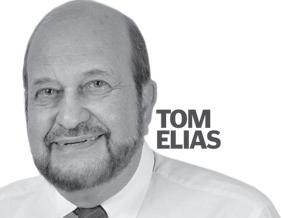
Nor has DWP fully addressed community groups’ concerns that hydrogen combustion will continue to produce pollution.
Thanks to opposition by the city’s tireless environmental justice advocates, the city council tasked DWP with considering some of these alternatives and addressing the unsolved threat of nitrogen oxide emissions. But the possibility that leaking hydrogen will make the project a climate threat hasn’t yet been confronted.
DWP is hardly the only Californian institution rushing to commit to hydrogen.
SoCalGas, one of the state’s largest natural gas utilities, hopes to blend hydrogen into the gas network that supplies homes and businesses across Southern California. To do that, it has begun work on a massive hydrogen pipeline project called the Angeles Link, and is planning tests in campus buildings at UC Irvine. Meanwhile, a Bay Area transit agency is preparing to manufacture hydrogen to power a new train line linking Alameda and San Joaquin counties.
Each of these projects plans to use hydrogen in a different way, and each has its own risks and rewards. Hydrogen warms the climate when it leaks into the atmosphere while being transported or stored, so projects that aim to move hydrogen around or store large quantities of it for long periods of time present the greatest climate hazard.
While DWP hasn’t publicly addressed the threat of hydrogen leakage, SoCalGas has claimed that its future hydrogen pipelines should be no leakier than its existing natural gas system. That’s extremely unlikely: Because hydrogen is the smallest molecule in existence, it’s also among the hardest to contain. Even taken at face value, though, SoCalGas’ claims are cold comfort considering their current system’s long history of leaks.
Now that Congress has approved generous new tax credits for hydrogen production in last year’s Inflation Reduction Act, California should be bracing for a much larger avalanche of new hydrogen proposals — some well-planned and necessary, and some frivolous or downright dangerous.
Most, like DWP’s Scattergood pilot, will fall somewhere in the middle. The climate threat posed by these middle-ground projects will depend on the details of their design, so it’s critical that regulators start pushing to minimize the chance of hydrogen leakage.
— Josh Lappen is a doctoral candidate studying the development of California’s energy systems at Oxford University. He was born and raised in Los Angeles.
The myriad activists for a putative State of Jefferson in the mostly rural counties of Northern California don’t need much prodding to spring into action.
But they may soon be getting a push anyway, this time from similar-minded eastern Oregonians eager to split off from their current state and join up with neighboring Idaho.
That movement, called “Greater Idaho” because it would shift 15 rural eastern Oregon counties into Idaho, has so far won voter approval in 11 of those counties and will get a vote in May in northeast Oregon’s Wallowa County (population 7,391). The Idaho Legislature’s lower house has already approved the concept.
While the Greater Idaho movement is far younger than the notion of a State of Jefferson, which originated in the 1940s, it has moved much farther toward its goal. It is even due for some discussion in the Oregon Legislature this year, with at least one state senator and one member of the lower house as sponsors.
The State of Jefferson, by contrast, has never gotten formal consideration in Sacramento. Its aim is not to
join another state, but to rip away from Oregon some of the same counties now amenable to joining Idaho and link them to Northern California in a new 51st state, its putative capital Redding, in California’s Shasta County.
Meanwhile, a nascent separatist movement in San Bernardino County won narrow approval from local voters last fall for a study of independent statehood. There’s been no action yet on that.
The State of Jefferson gets some support not only in Northern California, but also in southern Oregon, where roadside signs in cities like Grants Pass, Reedsport and Medford are readily visible.
It would be no surprise if California counties sympathetic to Jefferson joined Oregon areas pushing to join Idaho. Their complaints are the same: Most are politically more conservative than the dominant coastal, urban areas of their states.
As the Davis Cherry Blossom Festival enters its eighth cycle, I want to thank our community for their continued support and reflect on how this project has grown. Particularly, I would like to acknowledge the city of Davis Arts and Cultural Affairs Program for its support. The Civic Arts Commission’s current funding priorities include elevating the voices of people of color, and this directive has been meaningful and beneficial for our work, which we believe provides value to the whole community in turn.
The idea for the festival started while I was a student taiko performer, a markedly ethnic music that can lose its subtlety when employed in the interest of neoliberal multiculturalism. As a player, the cultural experience of taiko explores the representational politics of identity, imagines anti-capitalist ways of organizing, and brings together people of diverse diasporas
Many counties are wrapped into each legislative district in those regions, while some urban counties get dozens. That last has been true since California in the 1960s bent to the U.S. Supreme Court’s One Person, One Vote decision. Before then, state Senate seats were allocated by geography, so the northern counties often wielded significant power.
Now their mostly Republican representatives are part of small GOP minorities in both houses of the California Legislature.
It’s little different in Oregon, where tiny Wallowa’s populace would fit into a few Portland or Eugene city blocks.
The rural counties feel they suffer the same kind of taxation without representation that helped fuel the American Revolution and many folks there want out. They also despise gun control laws passed over the last few years in both Oregon and California.
In Oregon, they get some statewide sympathy. One poll often cited by Greater Idaho organizers found 68 percent of Portland area voters favor their Legislature at least discussing the idea of
and immigration histories. To the practitioner, taiko is the performance of living community, though to the novice observer it can be a celebration of “national” heritage. In reality, it mirrors the story of Asian America, and it is our goal to share our many stories through the festival.
In a time of heightening political polarization, we want this festival to be a place to develop compassion, bringing people together in a sort of “world-renewal,” as festivals have long done. It remains important to us to keep the festival free to attend and participate — that money not be a barrier or broker to cultural conversation.
Our festival is produced by a team of young Asian American organizers who direct a 501(c)3 nonprofit for this purpose. Through producing festivals, this team engages in community mentorship and develops political consciousness in-situ through grassroots organizing. It has become a joy to see young leaders emerge, as well as new artistic collaboratives. Third space projects can be notoriously fleeting, but the public support we receive has allowed the project to continue to create new realities — but isn’t that what the arts should do?
This year’s festival will be April 22 to 23
Hon. Joe Biden, The White House, Washington, D.C., 20500; 202-456-1111 (comments), 202-456-1414 (switchboard); email: http://www.whitehouse.gov/contact
U.S. Senate
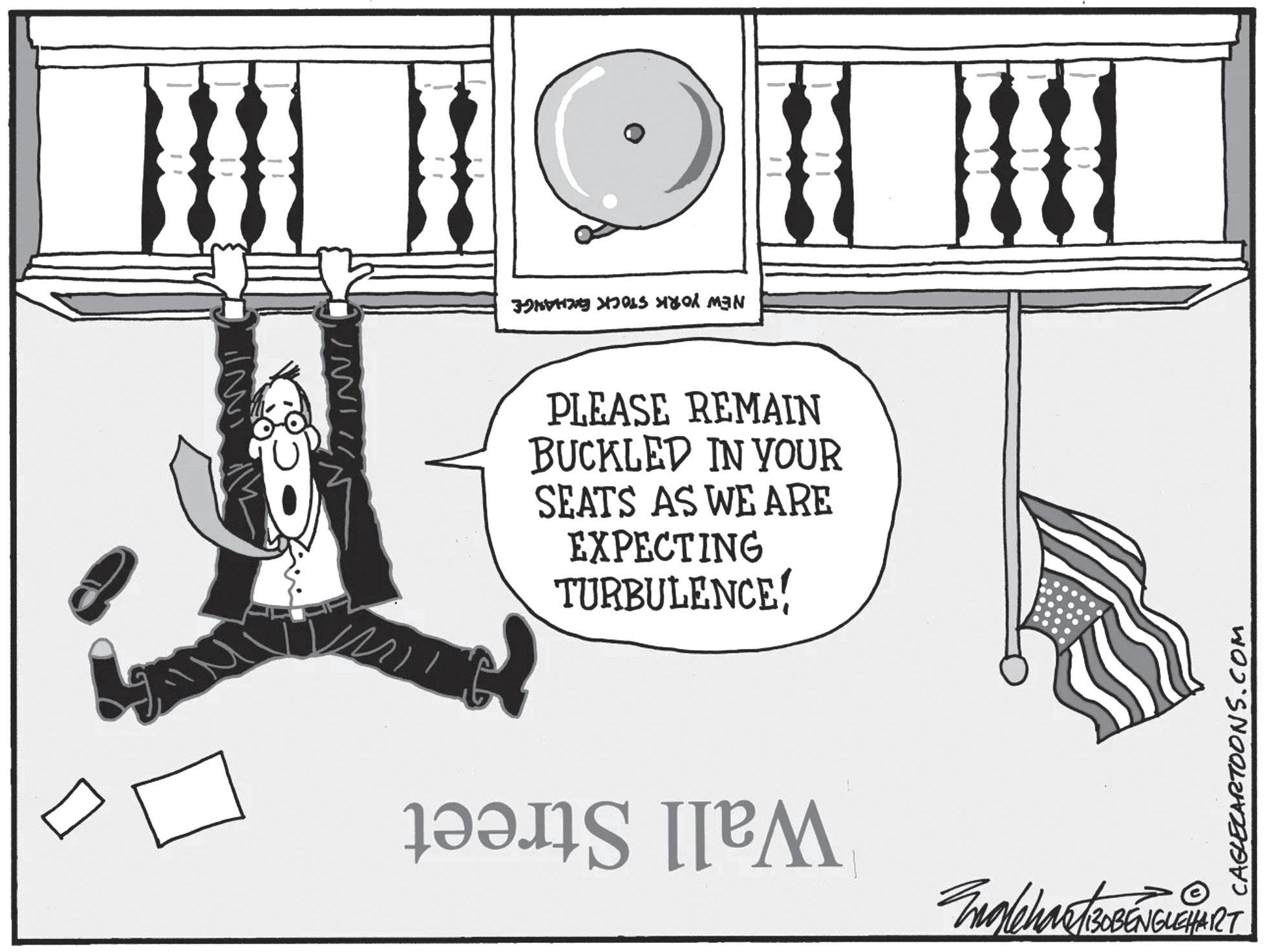
Sen. Dianne Feinstein, 331 Hart Senate Office Building, Washington, D.C., 20510; 202-224-3841; email: https://www. feinstein.senate.gov/public/index.cfm/ e-mail-me
Sen. Alex Padilla, 112 Hart Senate Office
Building, Washington, D.C., 20510; 202224-3553; email: https://www.padilla. senate.gov/contact/contact-form/
House of Representatives
Rep. Mike Thompson, 268 Cannon Office Building, Washington, D.C., 20515; 202225-3311. District office: 622 Main Street, Suite 106, Woodland, CA 95695; 530-753-5301; email: https:// https:// mikethompsonforms.house.gov/contact/ Governor Gov. Gavin Newsom, State Capitol, Suite 1173, Sacramento, CA 95814; 916-4452841; email: https://govapps.gov.ca.gov/ gov40mail/
separation. They note that losing many eastern areas would let that Oregon become even more solidly Democratic than now. But Greater Idaho and the State of Jefferson both face major roadblocks: Each would require a statewide vote to OK letting significant areas pull out, along with congressional support and statewide voter support for whatever property split was worked out between existing state governments and new or revised ones. Not to mention similar votes in Idaho, where voters would have to approve adding the rural Oregon counties which now get far more financial support from their state than they contribute via taxes. All of which means none of the current state splitting or state altering ideas has yet become serious business, just like all the other 42 ideas for new state lines proposed formally and informally since California entered the Union in 1850. — Elias is author of the current book “The Burzynski Breakthrough: The Most Promising Cancer Treatment and the Government's Campaign to Squelch It,” now available in an updated third edition. His email address is tdelias@aol.com.
(11 a.m. to 8 p.m.) at Sudwerk Brewery, here in Davis.
Gregory Wada DavisTwo separate people spontaneously offered me aid Wednesday afternoon.
I had been riding my bike westbound on West Eighth Street when the 38-year-old front fork failed, sending me to the ground in a prolonged slide. A woman who had seen the action while driving eastbound came back and pulled up to ask me if I needed aid. Just then my cell phone connected with my wife, who was able to come pick me up, and I waved off the aid without a proper thank-you for the offerer’s kindness.
Later as I stood by my bike an eastbound cyclist swung a U-turn and also offered her help. I demurred, at least with a thank-you, although again not as effusive as was certainly warranted. Thank you both. Your kindness to a stranger provided me with a feeling of community that warmed my heart.
Mick Klasson Davis

 By Jerry Scott and Jim Borgman
By Jerry Scott and Jim Borgman

 By Jerry Scott
Stephan Pastis
By Jerry Scott
Stephan Pastis
 Charles M. Schulz
Charles M. Schulz
From Page B6
joining the Delta League.
“This caught us off guard,” said Garrison of Wright’s proposal.
The committee took no action on Wright’s plan.
The realignment committee will send out the final proposal to member schools for a vote before the month is over.
The section’s Board of
Managers will vote to confirm the approved realignment proposal Wednesday, April 26. Davis can appeal to the Board of Mangers if it wants to pursue the idea of playing in the MEL for football only.
— Contact Mike Bush at mike@davisenterprise. net. Follow on Twitter: @ MBDavisSports.
From Page B6
41-03.00. Cody Leveau was third at 40-04.00.
Emma Vogt and River Salinas were first and second in the 200-meter race at 26.54 and 26.59 respectively.
Vogt was another double-winner for the Blue Devils. She took first place in the triple jump at 33-10.00.
Salinas was second in the 100-meter race at 13.15. Norah Dulaney and Avery Wolk were also a 1-2 finish, this one in the 1600 at 5:18.02 and 5:25.93.
From Page B6
The top eight teams in the country will be invited to compete.

The 49ers announced Thursday that they have hired Steve Wilks as
defensive coordinator.
Wilks, 53, joins the 49ers from the Carolina Panthers (2022), where he was promoted to interim head coach in Week 6 after initially serving as the secondary/defensive pass game coordinator. The Panthers went 6-6 and finished second in the NFC South under Wilks fol-
lowing a 1-4 start to the season.
Prior to Carolina, he spent the 2021 season as the defensive coordinator at the University of Missouri.
Before his time with Missouri, Wilks was the defensive coordinator for the Cleveland Browns (2019) and the head coach of the Arizona Cardinals (2018).
Sol Bitners won the discus with a toss of 139 feet, 6 inches.
“She is very close to our school record,” said Elliott of Bitners.

Bitners’ best mark is
144 feet, 8 inches.
Lauren Guerrieri has the school record at 155 feet, 9 inches that was set in 2007.
Michelle Kang was second in the triple jump at an even 33 feet.

Sophia Ballard was third in the same event at 32-03.00.
The next league center meet will take place on Wednesday, April 12 at Jesuit.
The league’s trial meet will be on Saturday, April 29 and finals on Tuesday, May 2. Both will take place at Elk Grove High. The Blue Devils are off until Friday, April 7, competing at the Arcadia Invitational.
The invitational runs through Saturday, April 8.
— Contact Mike Bush at mike@davisenterprise. net. Follow on Twitter: @ MBDavisSports.

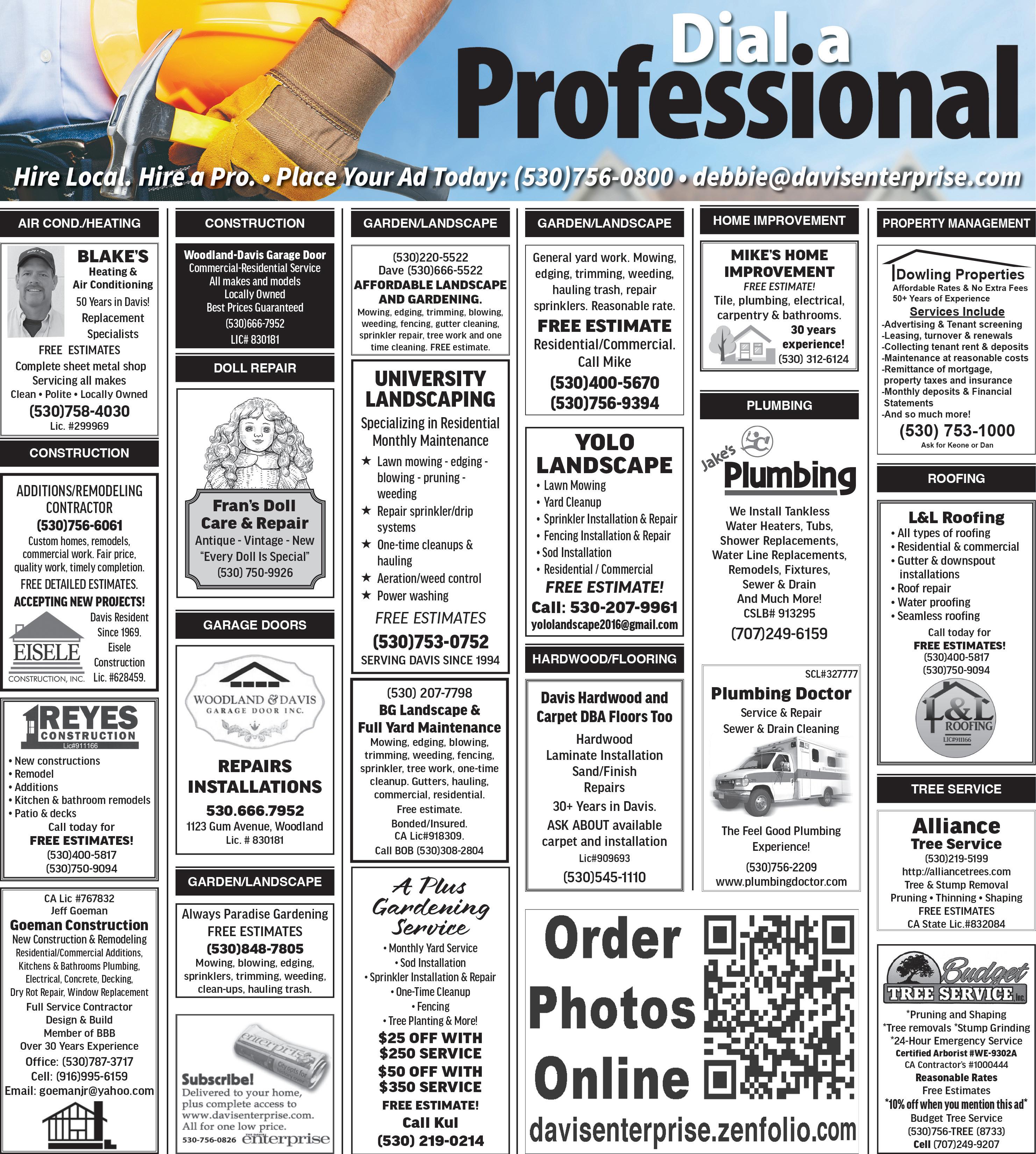
STOCKTON — In 18 months, Davis
High athletic teams will be facing new league opponents.
The Blue Devils will be facing the Golden Eagles, Bulldogs, Grizzlies, Trojans, Thunder and Wildcats.
But from now until May 2024, DHS will continue to play the Wolfpack, Thundering Herd, Wildcats, Eagles and Huskies.
For the next six years, the Blue Devils will continue playing the Marauders and Troubadours.
At Tuesday’s Sac-Joaquin Section league realignment meeting for the 2024-28 cycle at The Reserve at Spanos Park, the section’s committee moved to approve changes made in the 25 leagues in Divisions I-VII.
That included moving DHS to the eight-school Sierra Foothill League, which is D-I. Schools in the SFL are Del Oro, Folsom, Granite Bay, Oak Ridge, Rocklin
and Whitney of Rocklin. Since 2014, DHS has been in the Delta League, which is also D-I. Current members of that league are Elk Grove schools in Cosumnes Oaks, Elk Grove, Franklin, Pleasant Grove and Sheldon.
Jesuit and St. Francis, which are also in the Delta, will join Davis in the SFL. Jesuit is an all-boys Catholic school and St. Francis is an all-girls school of the same religion.
Elk Grove schools in Laguna Creek and Monterey Trail will join the Delta League for the next cycle. Both schools are currently in the Metro Conference, which is D-II.
During the morning session of Tuesday’s meeting, St. Mary’s Principal Michael Wright shocked nearly all school administrators and athletic directors present at the meeting by presenting a football-only proposal that would have moved his school to the SFL, DHS to the
Monticello Empire League that is D-III and West of Tracy into the Tri-City Athletic League, also D-I.
West is in the TCAL for sports currently, but will join the San Joaquin Athletic Association for football only in summer 2024.
The MEL members for the next cycle are Pioneer of Woodland, River City of West Sacramento, Rodriguez of Fairfield, Sacramento, Vacaville, Vanden of Fairfield and Wood of Vacaville.
Davis High Athletic Director Jeff Lorensen spoke to the league realignment committee after Wright gave his proposal.
“The program has struggled,” Lorensen told the committee of the Blue Devils football program.
Davis posted a 2-8 record during the 2022 season.
The Blue Devils have a combined record of 2-11 from the fall 2021 and spring 2021 seasons. The latter season was played due to the pandemic.
Lorensen was quick to point out that
DHS football had success toward the end of the 2010s.
The 2019 Davis football team won the Delta League crown with a 5-1 record. The Blue Devils beat Gregori of Modesto in the first round of the section’s D-I playoffs, then fell to Inderkum in the quarterfinal game and finished with a 10-2 record.
The 2018 DHS squad finished with a 6-5 mark, earning a first-round D-I playoff game.
A member of the league realignment committee asked Lorensen if this was a collective proposal with St. Mary’s and West, or looked at individually. Lorensen referred that question be asked to Wright.
Lorensen told the committee member that he would be OK with the idea of the Blue Devils going to the MEL.
Section Commissioner Michael Garrison told the committee that at one point he talked to St. Mary’s about
See DHS, Page B5
UC Davis center Noelle Wijnbelt elevates to take a shot on goal during a match against Long Beach State in 2021.
Enterprise staff
IRVINE — The UC Davis women's water polo team continues to dominate the weekly awards as Noelle Wijnbelt was named Big West Player of the Week following the center's outstanding play against two highly-ranked opponents.

Wijnbelt scored eight goals and drew five exclusions in two games last week. She led the team with four goals, including two in the fourth quarter, in an 8-7 win over No. 19 Indiana for the Aggies' sixth straight victory.
Then four-time All-American enjoyed another fourgoal performance against No. 11 Michigan while also drawing three exclusions.
The Aggies, who has won six of their last seven games, return to action Friday, March 31 hosting UC Irvine in a Big West Conference game. Start time is scheduled at noon.
The UCD equestrian team will travel to Brookings, S.D. to participate in the Eastern Collegiate Athletic Conference dual disciple equestrian championship on Thursday.The Aggies, seeded third, will open postseason action against second seed Delaware State in a twoday semifinal affair that begun with Flat on Thursday.
The remainder of the contest will be completed on Friday.
Delaware State won by tiebreaker when these two programs last competed in November. If UCD advances, it will face the winner of UT Martin and South Dakota State/Minnesota Crookston in the ECAC Championship on Saturday.
South Dakota State and Minnesota Crookston are the ECAC Nos. 4 and 5 seeds respectively. UT Martin earned the top seed in the conference. A strong performance this weekend could earn the Aggies an invitation to the National Collegiate Equestrian Association National Championship, which begins on April 13 in Ocala, Fla.
See HONORS, Page B5
One down and one to go.
The Davis High boys and girls track and field teams hosted the first Delta League Center Meet at Ron and Mary Brown Stadium on Wednesday.
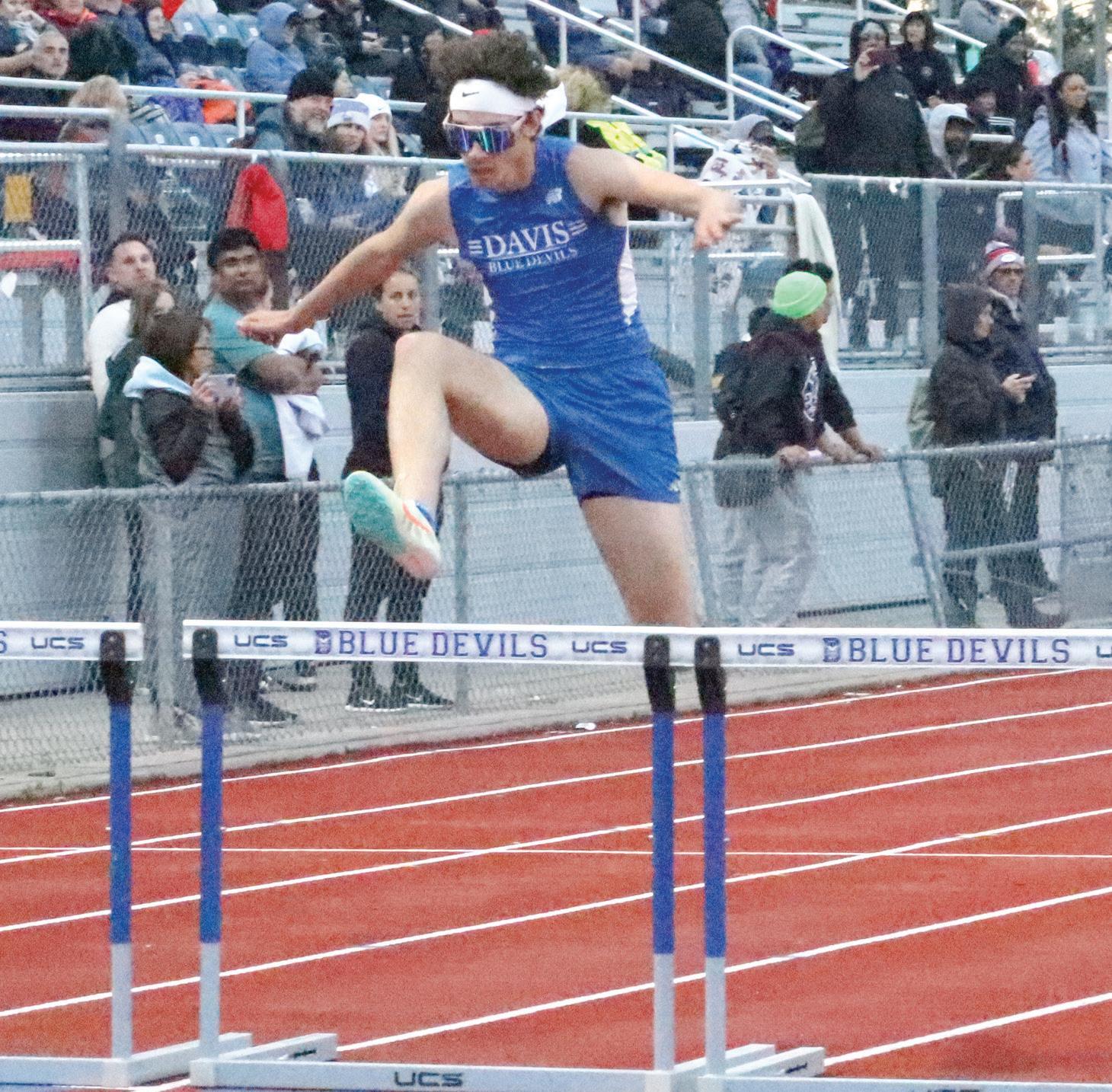
Many Blue Devils had strong finishes against fellow Delta schools in Cosumnes Oaks, Elk Grove, Franklin, Jesuit, Pleasant Grove, Sheldon and St. Francis.
Here are some of the Blue Devil winners, which included some winning two and three events.
Ben Feyrer took first place in the 110-hurdles with a time of 16.83 seconds.
“This was his first time racing this event,” said DHS head coach Spencer Elliott. “He won it with a great time.”
Feyrer was a triple-winner, taking the triple jump with a leap of 43 feet, 8.5 inches.
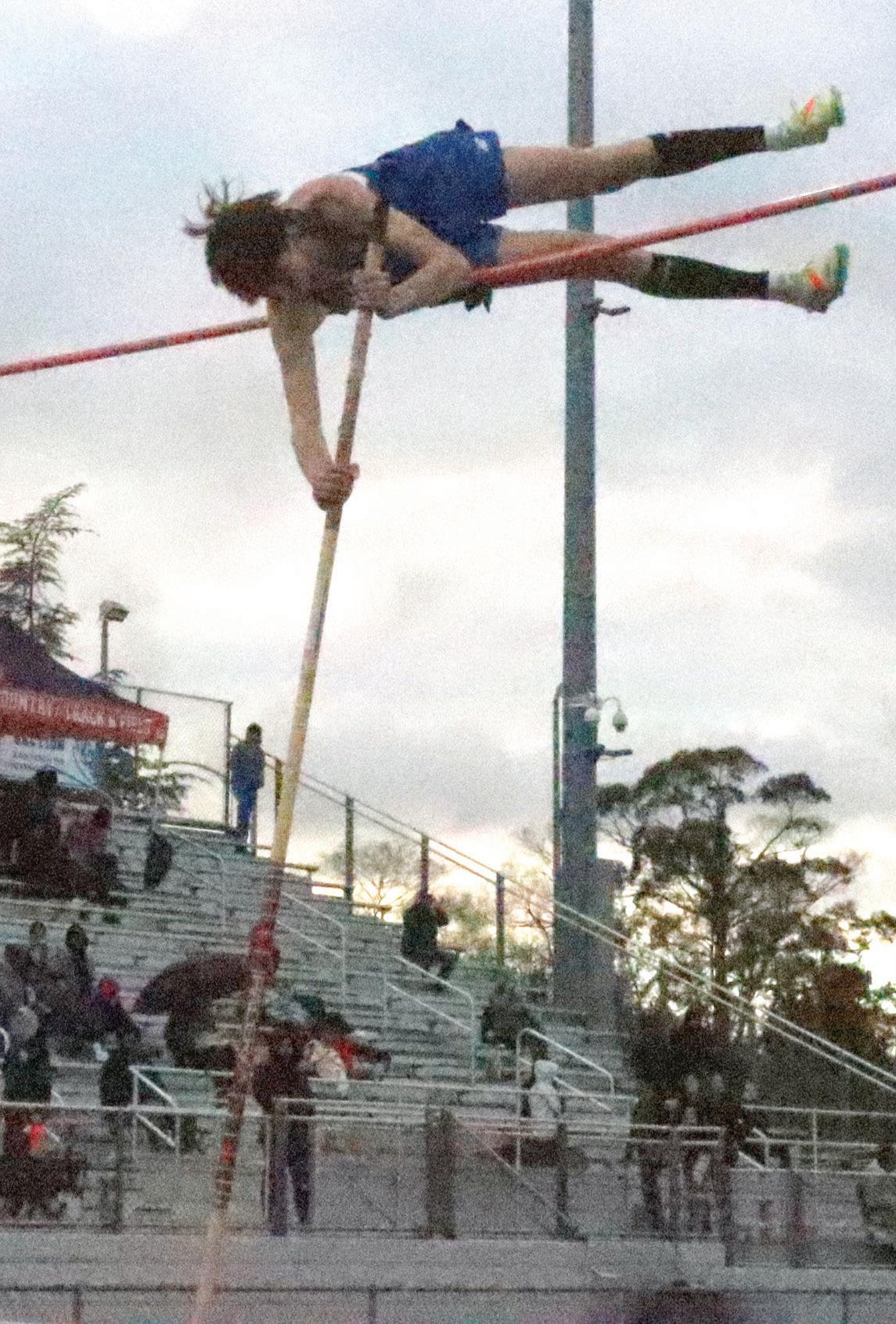
He finished the meet with taking the high jump at 5 feet, 10 inches.
Blue Devil runners Ryan Mitchell, Lucas Tam and Jefferson Wright finished in first, second and third respectively in the 1600-meter race.
Mitchell had a time of 4 minutes, 26.11 seconds. Tam at 4:26.74 and Wright at 4:32.61.
“These are really good early season marks,” Elliott said.
Lucas also won the 800 meters at 1:59.94.
Thomas Albeck was second in the triple jump at